Delhi is a popular entry point to India. It’s the country’s capital and third largest city, so there is tons of stuff to see and do. Three days is a perfect amount of time to spend in Delhi, and this itinerary will help you fill those days perfectly.
In this post, we’ll explore the ins and outs of planning a trip to Delhi (like where to stay and when to go). Then we’ll walk you through a detailed three-day trip, including what to do, how to get there and how much it’ll cost. Keep reading to plan you perfect three-day trip to Delhi, India!
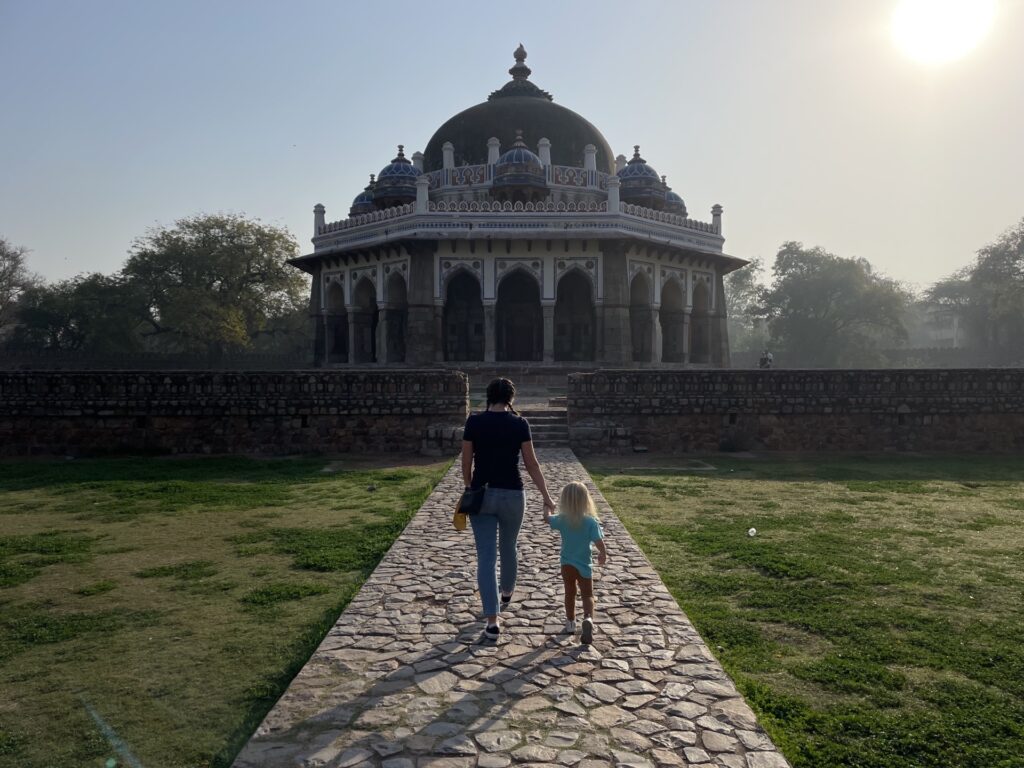
In this post
Here’s what we’re covering in this post. We’ll start with some general planning information and then get into the itinerary itself.
- Meet Delhi
- Plan your trip to Delhi
- Getting around Delhi
- About this itinerary
- Day 1 — Old Delhi
- Day 2 — Old Meets New
- Day 3 — Mughal Tombs and Garden Oasis
- Tips for visiting Delhi
Meet Delhi
Delhi has a long, rich, and sometimes tragic past. I won’t pretend to be an expert, but I will tell you what I saw and what you can expect to experience.
When we arrived in Delhi, we met our driver and got into an air conditioned SUV. After that, no experience in Delhi was like anything we’d experienced before. For three days I watched in awe as a new world unfolded around me.
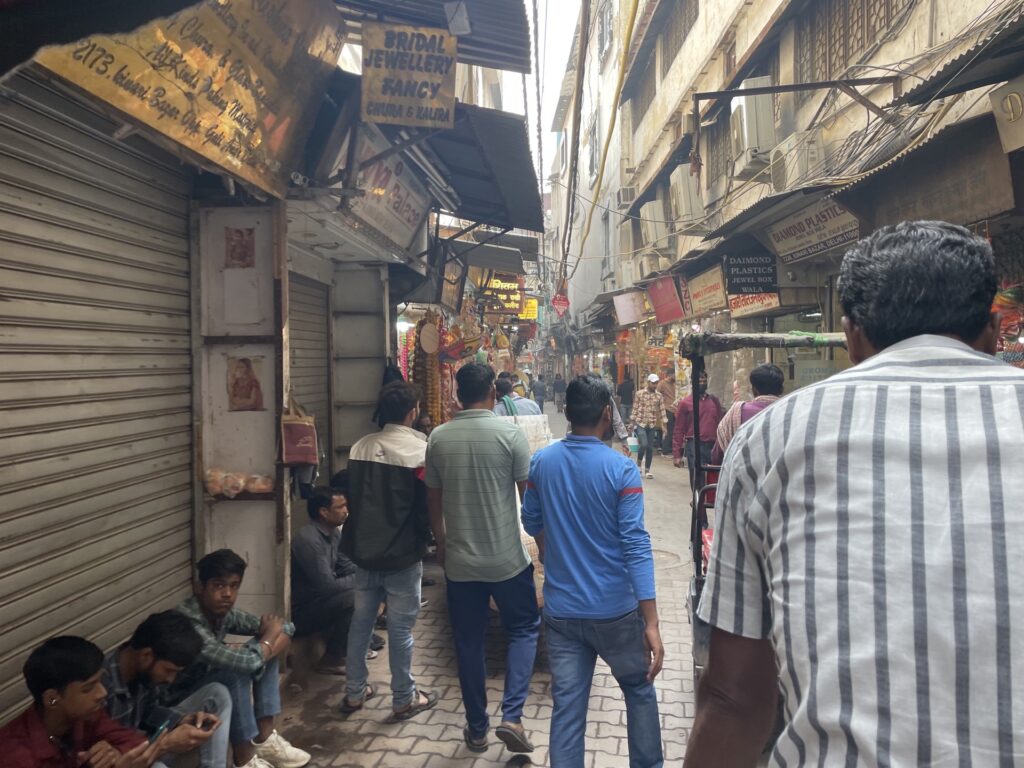
The first thing that stood out was the traffic. Things like lanes and traffic signs were more of a suggestion than a rule. The roads were completely filled with cars, tuk tuks and motor bikes, and yet somehow there was always room for more. Horns blasted constantly, but in a polite way as to say “Hi! I’m here!” and not “You’re in my way!” I generally get car sick, but I found this ballet of traffic to be mesmerizing and almost soothing.
When I looked past the vehicles, I started to see the people. The poverty in Delhi is intense, it is in your face and it will break your heart. People all around were living in dilapidated buildings, shanty villages, and on the ground. We saw families bathing and doing laundry on the street and kids walking around barefoot. I don’t want to harp on this, particularly because I don’t have a call-to-action or solution, but I also can’t not mention it.
In our experience, the people of Delhi were kind and polite. We have a blonde toddler, and lots of people asked to take photos with us. They didn’t understand why our baby didn’t want to be held by strangers (something that’s totally common there), but they respected it. They were also really proud of their city and country. India is hosting the G20 summit and everyone was so excited to tell us about it.
Delhi has two main areas: Old Delhi and New Delhi. The people we spoke with said that they don’t think of it that way though, they just think of it as “Delhi.”
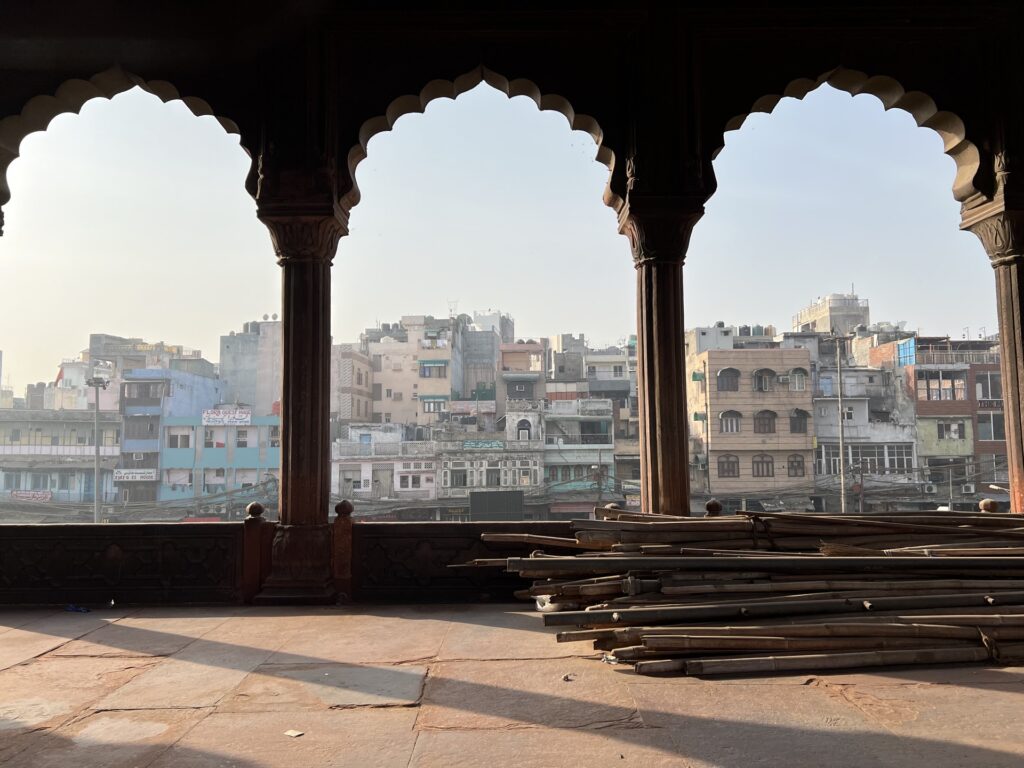
Old Dehli is the historical center of the city that once served as the capital of the Mughal Empire. This area is dense with shops and restaurants and made up of many winding, narrow streets. Monkeys jump along the rooftops, sacred cows casually cross the street, and rickshaws zip around with impressive agility.
Contrastingly, New Delhi is incredibly spread out. This area, built out during the British rule in the late 1800s, features wide European-style boulevards and huge traffic circles. In this part of town you’ll find large museums, government buildings, and the city’s most expensive homes.
I’d often heard Delhi described as an assault on the senses, and I honestly didn’t feel that way. The city definitely has an intensity about it that is different than I’ve experienced before, but it wasn’t as overwhelming as I was expecting. Everyone living in this seemingly chaotic space felt so comfortable, and that put me at ease in a way.
We really enjoyed our time in Delhi and I hope you will too.
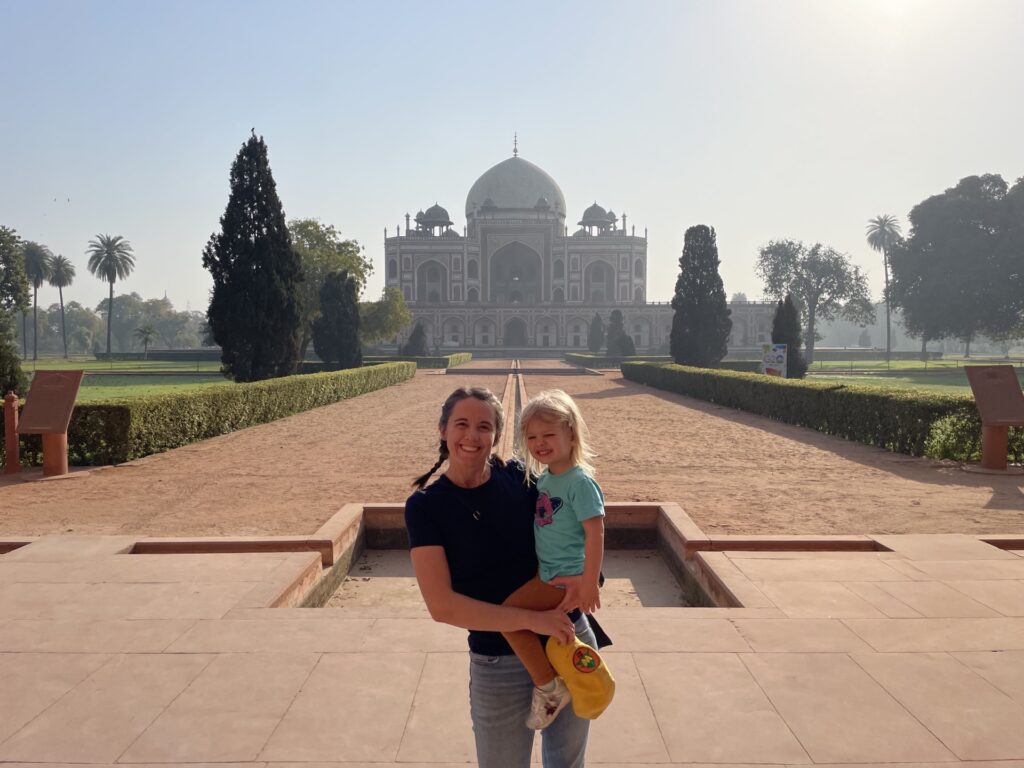
Plan your trip to Delhi
Let’s jump into planning a trip to Delhi. Here’s the practical information you’ll need to know to book your trip.
India Visa requirements
If you want to visit India, you’ll first need to get a Tourist e-Visa. The Tourist e-Visa is required for visitors from almost every country and has three available durations (30 days, 1 year, 5 years).
You can apply for an Indian Tourist e-Visa online. You will need a valid passport, passport photo, and credit card to pay the application fee. The application fee varies based on your nationality, but most will pay $10 or $25 USD for a 30-day visa.
In most cases, this is a quick and easy process, but don’t put it off to the last minute. It can take longer if complications come up.
Kenny submitted his application first and discovered that the portal had a cap on how many countries he could put in his travel history. He had to send a separate PDF with a list of the countries he’s been to, which delayed his approval. Having learned from his situation, I was able to submit mine accurately the first time and was approved the next day.
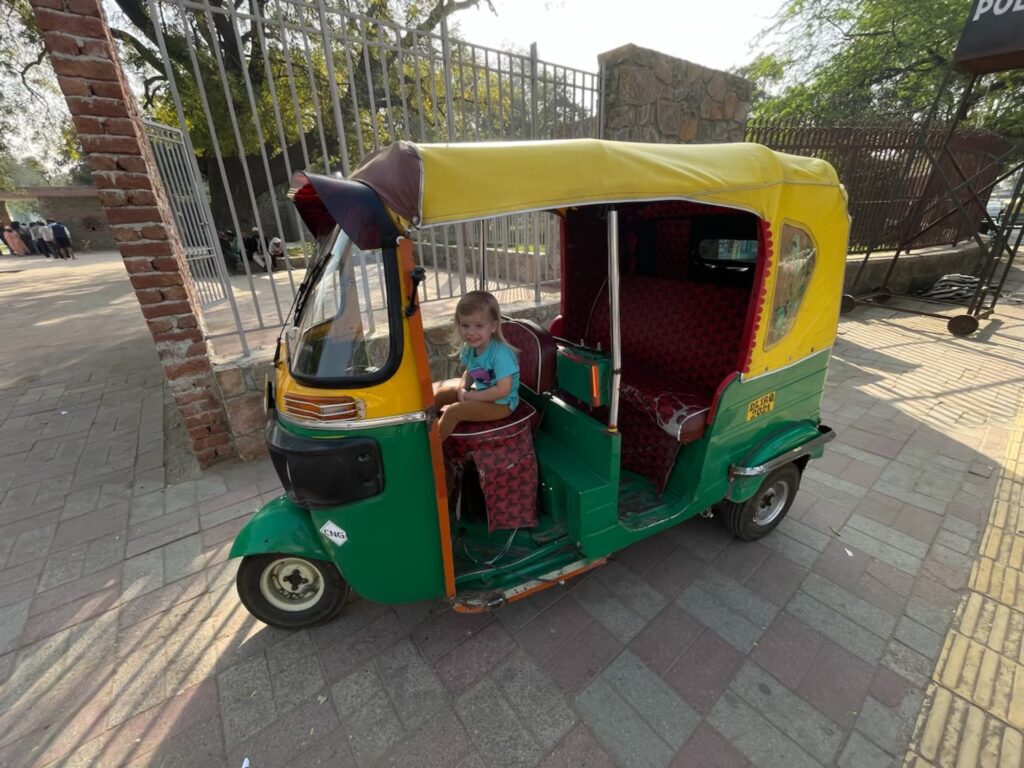
Recommended vaccines
India does not have any vaccine mandates, but you might want to get a few before traveling there. In the United States, the CDC recommends the following vaccines for travelers going to India. Other countries may have different guidelines.
(Disclaimer: We are not doctors and this is not medical advice. Consult your physician or a travel clinic for professional recommendations.)
- COVID-19
- Hepatitis A
- Hepatits B
- Measles
- Yellow Fever
- Rabies
- Typhoid
- Cholera (not prominent in Delhi)
- Malaria (not prominent in Delhi)
- Japanese Encephalitis (not prominent in Delhi)
We were already up to date with most of these vaccines including: Covid, Hep A, Hep B and measles. We also already received Yellow Fever vaccines before traveling to Colombia a few years ago. Based on our travel plans (Delhi, Jaipur, Udaipur, Agra), we weren’t at high risk for cholera, malaria or Japanese Encephalitis. That left us with Rabies and Typhoid to consider.
If it was just us adults, we probably would have skipped both. But we are responsible parents traveling with our 2-year-old, so we had a travel consultation with our pediatrician. She actually didn’t strongly recommend any vaccines other than Hep A, which we were due for anyway.
We decided to skip the rabies vaccine. Stray dogs are definitely a thing in Delhi (they are just about everywhere), but we assumed we would be able to stay pretty clear of them. Typhoid spreads through contaminated water, though, and that seemed like a risk that would be harder to avoid completely. We decided to get the Typhoid vaccine for all of us.
The Typhoid vaccine is expensive. It costs around $150 and most insurance doesn’t cover it. (Our insurance covered children but not adults.) It’s also really hard to find. In many cases you have to go to a travel clinic to get it, which can sometimes cost another few hundred dollars. Some CVS locations carry it, especially in major cities, so be sure to check there.
How to get to Delhi
The flag carrier airline of India is Air India. While Air India isn’t known for being one of the better airlines, we personally had a pleasant experience flying Air India Business Class from Dubai to Delhi. I wouldn’t recommend flying Air India long-haul, but it’s a fine option if you’re traveling regionally.

Plenty of other international carriers fly to Delhi, so you’re probably better off flying your home country’s flag carrier instead.
Regardless of airline, you will probably fly into Indira Gandhi International Airport (DEL).
There is a Metro stop at the airport, so you can take the Airport Express Line into the city. The Delhi Metro isn’t particularly thorough though. If your hotel isn’t off a Metro stop, this won’t be super helpful.
In that case, your best bet is to take a car. Taxis are available at the airport and offer pre-paid or metered fares. The airport website recommends pre-paid, which requires going to the taxi counter to get a ticket first. Uber is also available in Delhi, so that’s a better option as long as you have cell service or wifi (there is free wifi at the airport).
Another option is to book a car service to be waiting for you when you arrive. We booked a car service through our hotel, and it was incredibly smooth. They were waiting for us with a sign when we cleared customs and they got us right to where we needed to be without any hassle.
Where to stay in Delhi
When it comes to accommodations, you kind of have two options in Delhi. You can take the budget route — which will be incredibly cheap but of varying quality/comfort/safety — or you can go the luxury route — which will be incredibly expensive but a total oasis. There’s not a lot of middle ground in Delhi.
If you want to take the Metro around town, consider staying near Connaught Place. From here, you can easily connect to the Blue Line, Yellow Line and Airport Express Line. This area is pretty touristy and has a lot of hotels and chain restaurants nearby.
If you’re not staying off the Metro, then you’ll mostly be taking cars or tuk tuks around town. In this case, picking your hotel by quality is probably more important than by location. (This is true within reason. You still wan’t to be relatively central. Don’t stay at the JW Marriott by the airport the whole time, for example.)
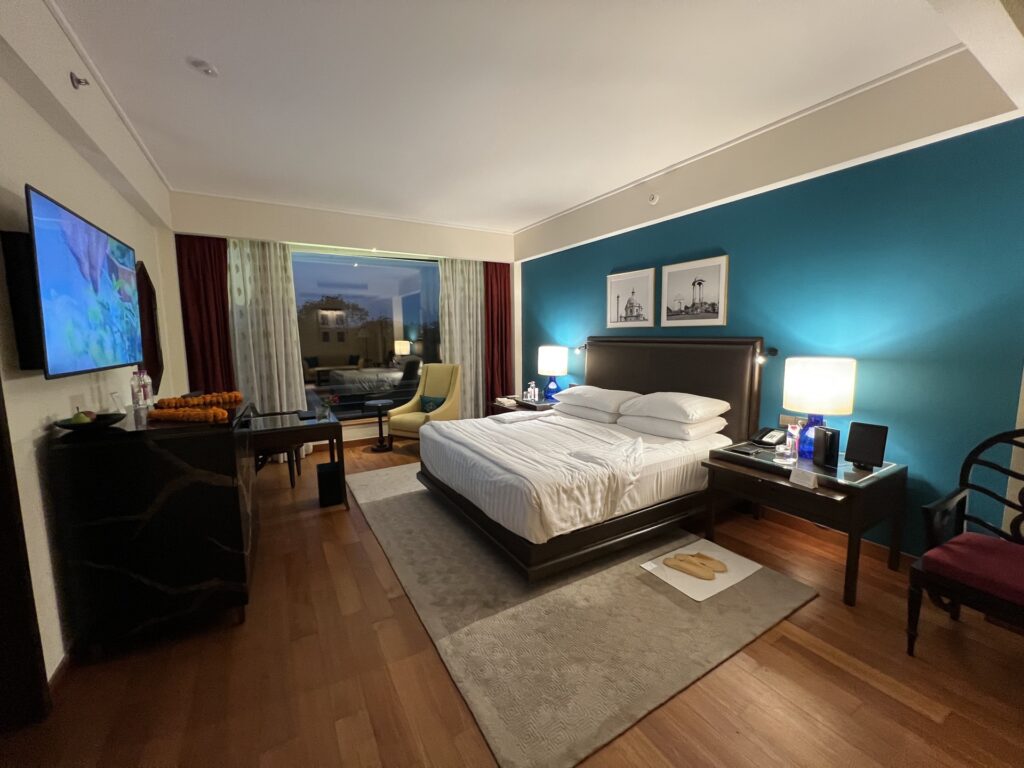
Personally, we went the luxury route. We stayed at The Oberoi New Delhi and it was incredible. It was one of the best hotel experiences we’ve ever had. The property was beautiful and the staff were so incredibly welcoming, kind and accommodating.
Staying at a nicer hotel also makes dining simpler — if you want it to be. A lot of people get stomach bugs in Delhi, mostly due to contaminated water. If you stay at a nice hotel that has a restaurant, you can generally trust the quality to be mostly safe. (You may still want to avoid uncooked produce, ice and tap water though.)
In a place like Delhi, it was immensely comforting to have a nice hotel to retreat to at the end of the day. The quiet and calm space gave us the chance to recharge so we could experience and appreciate the intensity of the city. If you can afford it, we’d definitely recommend splurging on a nice hotel in Delhi.

How long to stay in Delhi
As India’s capital, Delhi can be a destination on its own or an entry point to the rest of the country. How long you spend in Delhi will depend on how much time you have and what else you’re doing. We think three days is perfect, but here’s how some other durations can fit into your travel plans.
- 1 day in Delhi is enough if you’re starting a longer trip in India. If you’re flying into Delhi and then continuing on to another region or city in India, spending one day in Delhi is a good place to get your first taste of the country. If you only have a day, spend it in Old Delhi.
- 2 days in Delhi is enough if you are doing the full Golden Triangle. If you pack your days full, you can see a lot of Delhi in just two days. You’ll get to experience Delhi but still leave time for Jaipur and Agra.
- 3 days in Delhi is enough if you are pairing Delhi with one other city. Three days in Delhi is really the sweet spot. Spend three days in Delhi and then three days in another city in India (maybe Goa or Udaipur) and you’ve got a perfect holiday.
- 4 days in Delhi is enough if you are taking a day trip to Agra. This is really the ideal scenario if you don’t have a ton of vacation days. You can see a good chunk of Delhi and the Taj Mahal without changing hotels or adding any extra flights.
- 5 days in Delhi is enough if you want to see it all at a relaxed pace. If you want to really take it all in, visit more museums and make sure you hit all the sites, you’ll want to spend five days (or more!) in Delhi.
We were in India for two full weeks and spent 3 days and 4 nights in Delhi. The itinerary below outlines exactly how we filled those three days. Based on our total experience in India, if a friend asked us what they should do, we would tell them to spend four days in Delhi with a day trip to Agra. If they had more time, we’d send them to Dubai for two days first to adjust to the time change before they hit the streets of Delhi.
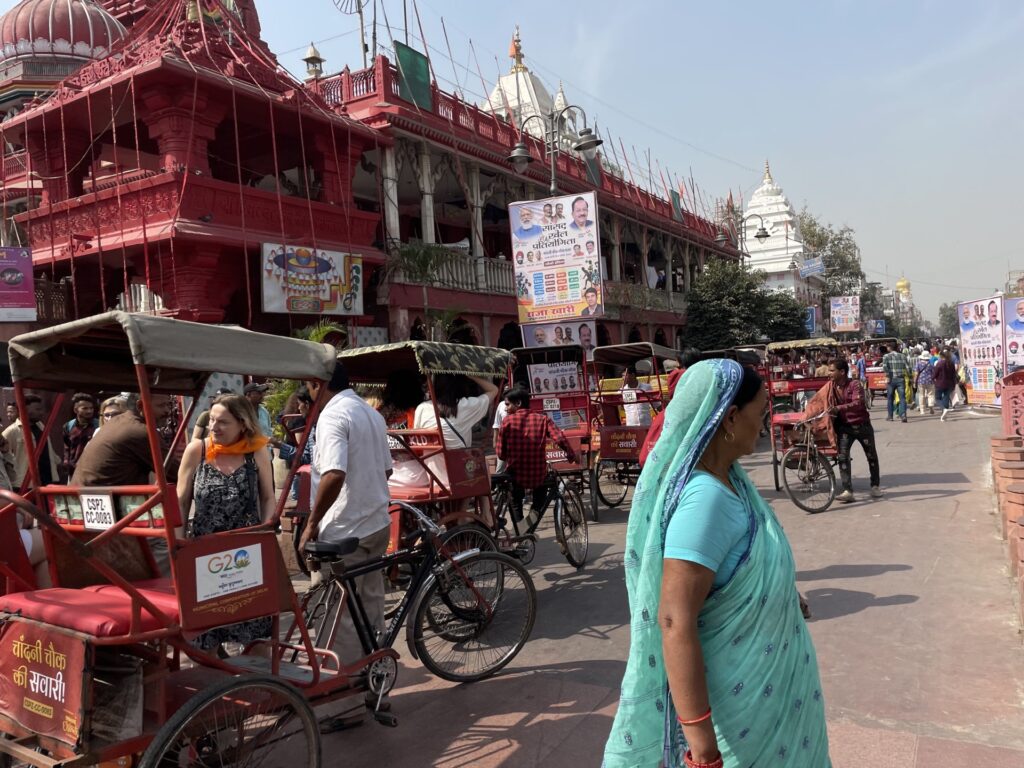
When to go to Delhi
Delhi has a unique and intense climate. The weather changes drastically by season, so you’ll definitely want to plan accordingly. Here’s a look at Delhi weather by season. All temperatures are in °F.
- Summer in Delhi (April – June): Summer is extremely hot with temperatures regularly hitting 100°F or higher.
- Monsoon Season in Delhi (July – September): The monsoon season starts in late June and brings with it heavy rains and humidity. Temperatures can dip into the 80s but can still peak around 100 when it’s dry.
- Fall in Delhi (October – November): The rainy season gives way to a milder fall, which sees temps around the 70s/80s and hardly any rain.
- Winter in Delhi (December – January): Delhi actually gets quite cold in the winter, with lows dropping to the 40s and highs in the 60s.
- Spring in Delhi (February – March): Temperatures shoot up quickly in the spring and can vary greatly by the day. Highs will hit the 70s and 80s and lows will move up to the 50s.
The best time to visit Delhi is in the late winter or early spring (January through March). You definitely want to avoid the summer’s crippling heat and monsoon season, which can easily damper any holiday.
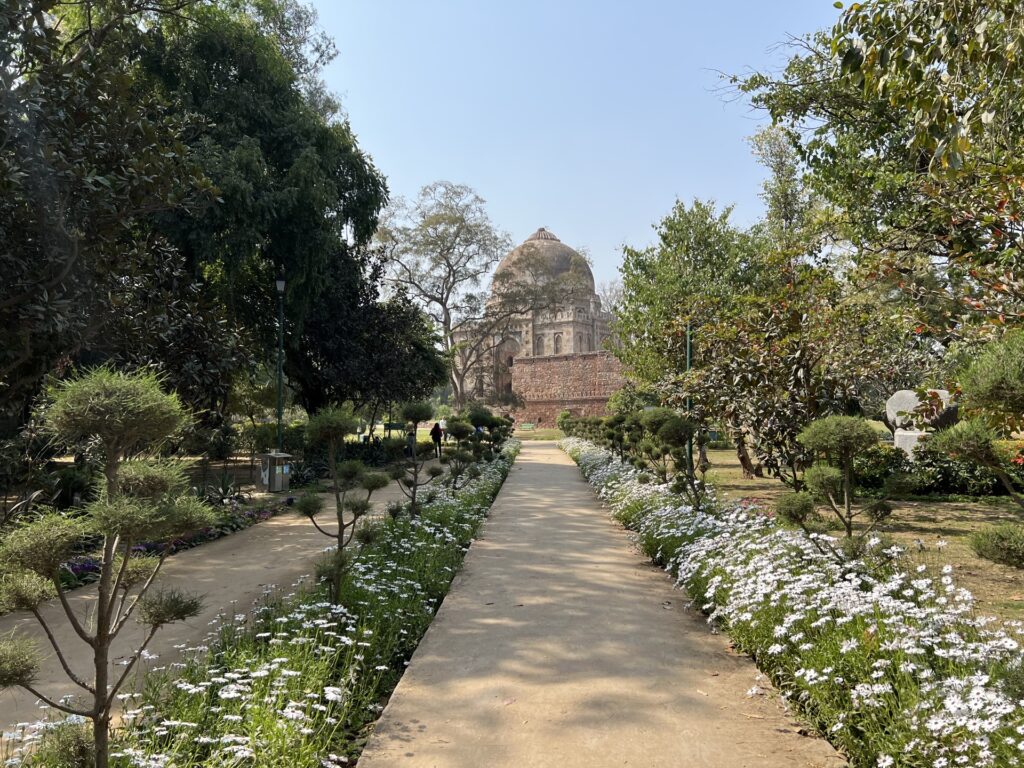
Getting around Delhi
Delhi is a really fun city when it comes to transportation. Depending on where you’re from and where you’ve been, you might even get to experience something you’ve never done before! Here’s a peak at your transit options in Delhi.
- Metro: The Delhi Metro is a great way to avoid the traffic and get around Delhi fairly quickly and cheaply. The system isn’t very thorough though, so it won’t get you everywhere. Trains run from 5 AM to 11:30 PM. Fares are based on distance and day of the week and range from Rs. 10 – 60 (less than $1 USD).
- Tuk Tuk: These three-wheeled motorized open-air taxis are driven all over Delhi. They’re perfect for covering short distances around the city and are often much easier than dealing with an actual taxi or Uber. Flag one down and agree on a price before you get in. (TIP: Check the Uber price to help set a baseline price.) Pay in cash when you reach your destination. You usually want to have exact cash, so keep small bills on you.
- Rickshaw: Rickshaws are the primary mode of transportation through and around Chandni Chowk (Old Delhi’s famous market area), as tuk tuks and cars are not allowed. Like hiring a tuk tuk, you should agree on a price first and plan to pay exact cash at the end.
- Uber: Uber is available in Delhi and is generally a good, cheap way to cover longer distances. You’ll need to have cell data or wifi in under to use the app.
- Car Service: The most expensive but easiest way to get around Delhi is to hire a driver. Most hotels will offer this service. It’s a great option if you know you want to see and do a lot around the city and don’t want to waste time figuring out transportation between each attraction.
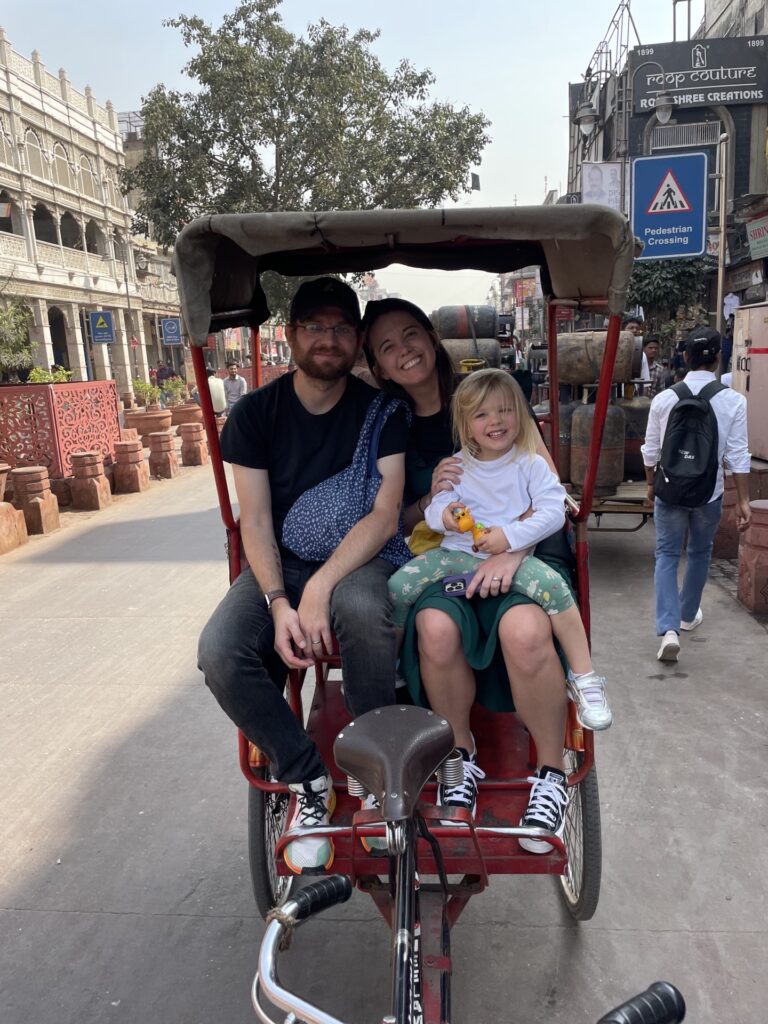
You’ll note that I didn’t mention walking. Delhi isn’t great for pedestrians — well, at least not for tourist pedestrians. The city has sidewalks, but as our guide told us “it’s just not comfortable to walk,” and that’s a good way to describe it.
In Old Delhi, the narrow streets are too congested with rickshaws and tuk tuks. The windy market streets are also hard to navigate, and it’s not a place where you want to be buried in your phone. And then in New Delhi, the sites are too spread out and traffic circles and intersection are dangerously wide.
We generally love exploring cities and neighborhoods on foot, but it just didn’t make sense to do in Delhi.
About this Delhi itinerary
In this itinerary, we are sharing the details of a 3-day/4-night trip to Delhi. We followed this exact itinerary in February 2023 with two adults and one child.
You’ll find that this itinerary is not packed to the brim. Each of our days wrapped up by about 1 PM. In a city as busy as Delhi, it was actually really nice to have the afternoons to decompress. Since we were traveling with a 2-year-old, we spent our afternoons napping and swimming in the hotel pool. If that isn’t your reality, you could easily take a bit more time at each stop or add more attractions to your day.
This itinerary requires some sort of car/tuk tuk transportation, as all of the sites are not on the Metro. We booked a car with a driver from 8 AM to 1 PM each day, which we’d recommend if it’s in your budget. Alternatively, you could use Uber or hire tuk tuks to move between locations.
Lastly, all prices listed throughout this itinerary are for one adult foreigner. At most of the sites, there is discounted pricing for Indians as well as concessions for children and seniors.
Alright, let’s go!
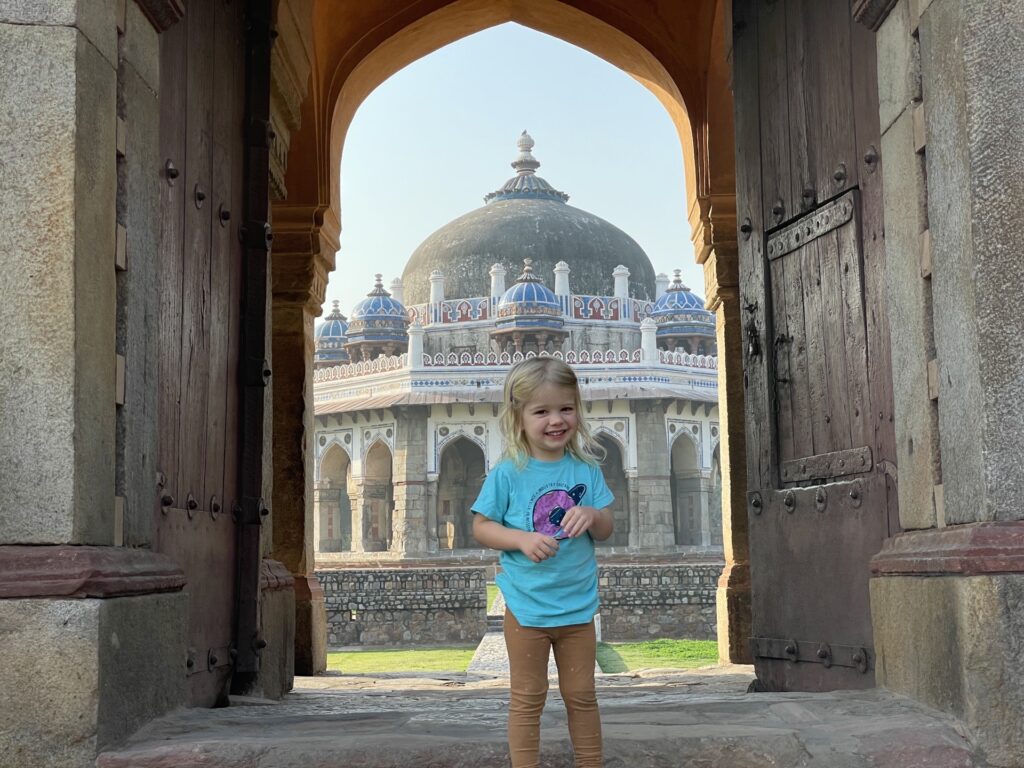
Day 1 — Old Delhi
We are diving head first into Delhi with some of the city’s most famous sites including the Red Fort and Chandni Chowk. This is probably the most intense day in terms of the actual experience and the logistics of getting around. If you only had one day in Delhi, this is how you should spend it.
Jama Masjid Mosque
- Location: Here – At the corner of Esplande Rd and Meena Bazar
- How to get there: (1) Have a car/taxi/tuk tuk drop you off at the mosque OR (2) take the Metro Violet Line to Jama Masjid station
- Hours: 7 AM – 12 PM and 1:30 – 6:30 PM (NOTE: The tower doesn’t open until 10 AM)
- Price: Rs. 300 ($4 USD) plus an additional Rs. 300 to go to the top of the minaret. Cash only.
- Tickets: No tickets, just pay at the gate.
- Guide info: There are guides at the entrance who will offer their services. There are no posted signs inside the mosque, so if you want to learn more you’ll need to hire a guide. (We didn’t get one.)
- How long does it take: 30 minutes (without the tower) or 1 hour (with the tower)
- Tips: If someone offers to take your photo, they’re going to ask for money! (And whatever you give, they will ask for more.)
Jama Masjid Mosque was built in the 1650s and is the second largest mosque in India. It’s an example of Mogul architecture, which is something we’ll see a lot of here in Delhi. Visitors cannot go inside the mosque, but you can visit the courtyard and the marble arch entryway. For an extra fee, you can also climb to the top of the 130-foot minaret for a birds-eye view over Delhi.
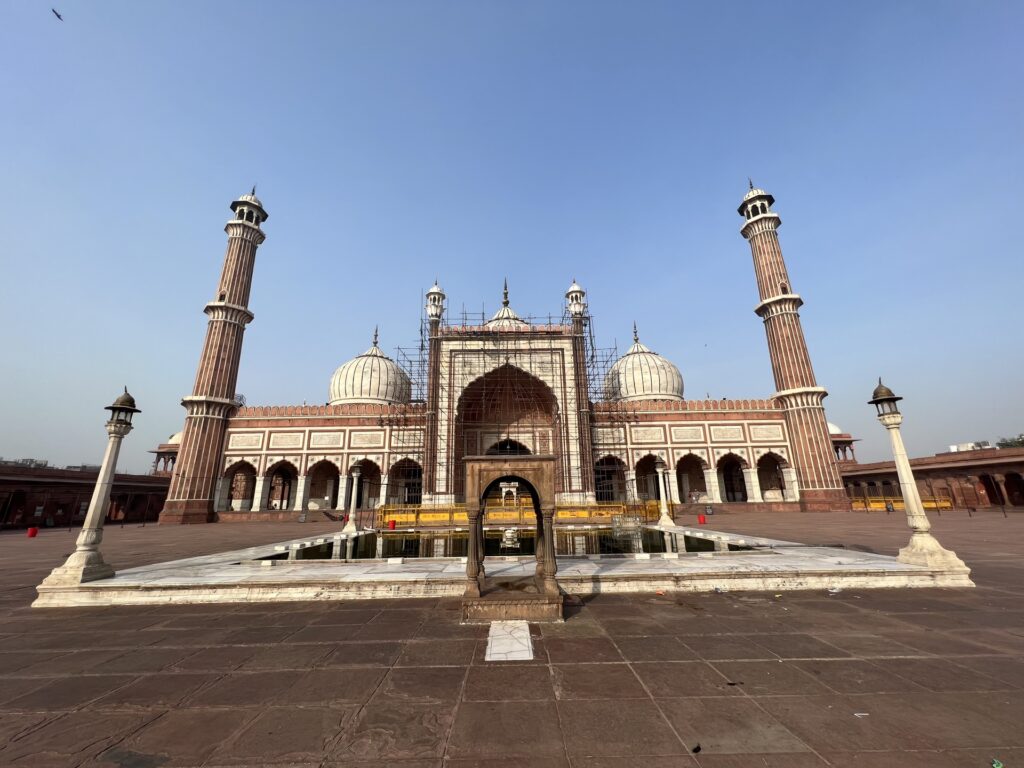
There are three gates to Jama Masjid Mosque, but visitors can only enter from Gate 3 on the east side. You will first need to pay the entrance fee (Rs. 300) in cash in order to enter. It’s sometimes called a camera fee, but everyone is required to pay it. Speaking of photos. Photos are allowed but video is not.
All visitors must remove their shoes, which you can leave near the entrance or carry with you. (We love to keep a foldable bag with us for just this purpose.) Women will also be provided a robe. Head scarfs are not required. I have read reports that people have been asked to pay a fee upon returning their robe or retrieving their shoes, though this was not our experience.
If you’d like to go to the top of the minaret, you can purchase a ticket from the ticket booth on the opposite side of the courtyard. The tower opens at 10 AM (later than the rest of the mosque). You must take the stairs to the top and there’s no elevator.
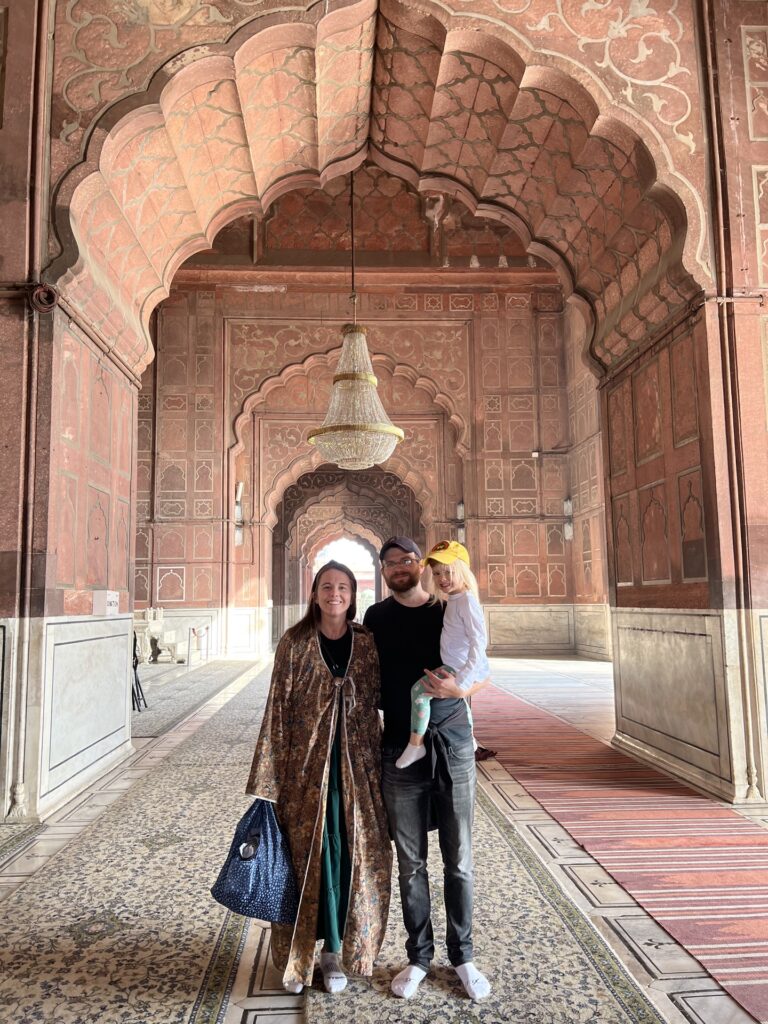
Red Fort
- Location: Here – The visitor entrance to the Red Fort is on the southeast corner of the fort
- How to get there: Hire a tuk tuk/rickshaw from outside the mosque and have them drop you off at the Red Fort Ticket Counter.
- Hours: Tuesday through Sunday, 9:30 AM – 4:30 PM. Closed on Mondays.
- Price: Rs. 550 ($7 USD) for fort only or Rs. 870 ($11 USD) for fort and museum
- Tickets: You can purchase tickets online in advance here. There is also a ticket booth at the entrance.
- Guide info: There are guides at the entrance who will offer their services. There are signs posted in both English and Hindi throughout the fort, so you don’t necessarily need one. (We didn’t get one.)
- How long does it take: 2 hours
- Tips: Large bags (including backpacks) are not allowed inside, so only bring a small tote. Visit in the morning for the lowest crowds.
The Red Fort is one of the most popular tourist attractions in Delhi and a UNESCO World Heritage Site. It was built in the mid 1600s as a royal residence after the capital was moved from Agra to Delhi. The Red Fort was designed by the same architect who built the Taj Mahal.
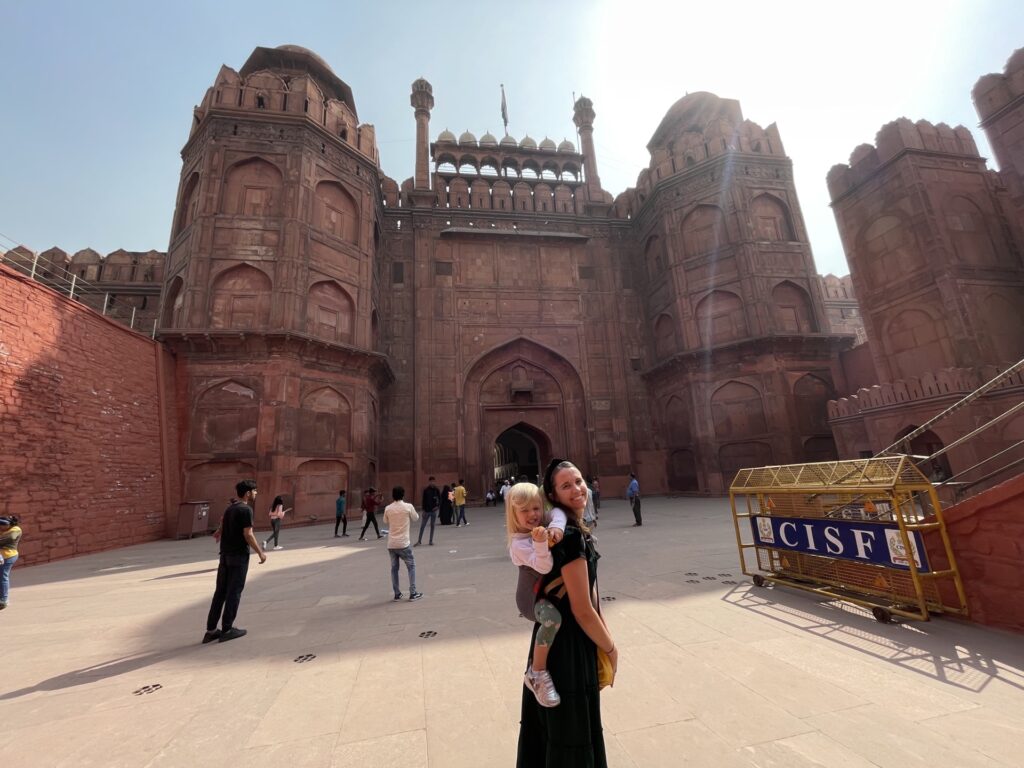
The entire Red Fort Complex is quite large. Visitors can walk the grounds, which features many different museums, gardens and structures. There are also a few different interactive exhibits, a market and a cafe.
There are several gates at the Red Fort, but only one visitor entrance near Delhi Gate on the south side of the complex. You can buy tickets online or from the ticket booth near this gate. From here, it’s an 8 minute walk to security and the main fort entrance. Rickshaws are also available for hire and cost Rs. 10 per person to cover this distance.
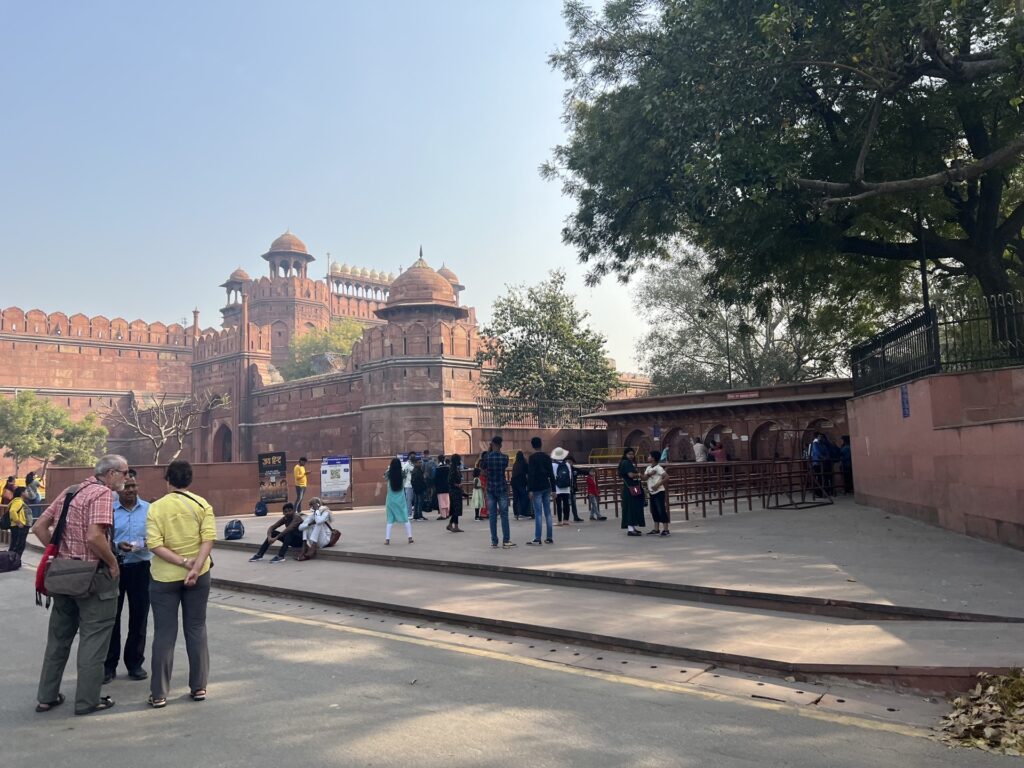
After the ticket check and security screen, you’ll walk through the main gate and then through the market. All items in the market have a set, posted prices and they don’t haggle. Prices are higher here than the rest of the city, but the simplicity might be worth it for you. They also take credit cards.
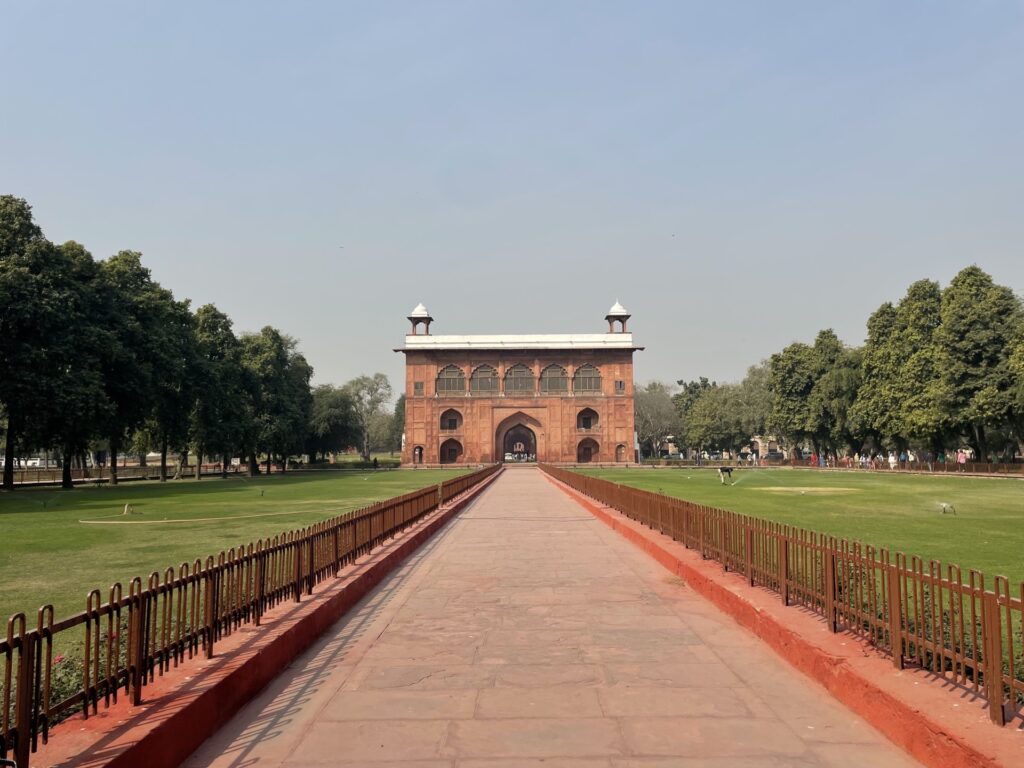
From here you can explore the grounds in any order. Some buildings and structures you can go inside, others you can’t. There are a few small museums, but they’re mostly just pictures and signs. The fort plus museum ticket covers these museums but not the interactive experiences like “Story of the Red Fort” or the 360 show.
The exit to the Red Fort is directly east of the main gate, near the start of Chandni Chowk Road.
Chandni Chowk
- Location: Here – Chandni Chowk Road between the Red Fort and Fatehpuri Masjid
- How to get there: Walk from the Red Fort exit to the start of Chandni Chowk Road
- Hours: Most shops are open Monday through Saturday, 9:30 AM – 8 PM. Closed on Sundays.
- Price: Rs. 50 – 100 + tip (<$2 USD) for a rickshaw ride through the market
- Tickets: N/A
- Guide info: There are rickshaws stationed at the entrance of Chandni Chowk Road. You can ask them to take you to a specific place, or just ask that they drive you around. Many will explain things as they go. Agree to a set price, but also be prepared to tip on top of that.
- How long does it take: 30 minutes via rickshaw, but longer if you walk.
- Tips: Keep your valuables (phones, wallet) close to you and concealed, as this area has a lot of pickpocketing. It’s also best to take a rickshaw through here. Walking can be stressful because of the traffic and heavy soliciting.
Chandni Chowk is the oldest market in Delhi, and one of the busiest. The small market streets packed with rickshaws, power lines dangling and open-air shops is quintessential Old Delhi. It’s known for overwhelming tourists with its intensity of sights, sounds, and smells.
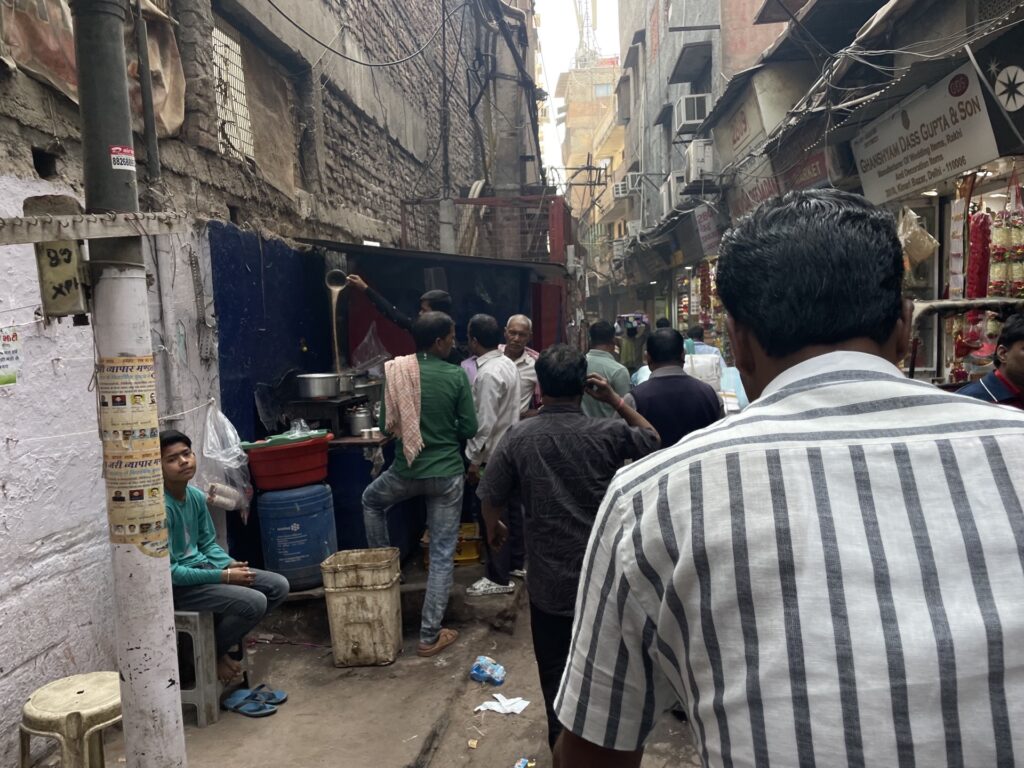
The market comprises Chandni Chowk Road (where you’ll find larger shops and stores, and even a McDonald’s) and all the tiny, windy streets that branch out from it (where the shop stalls sell everything from spices and flowers to textiles and jewelry).
While many similar markets like this appeal to tourists and hawk mostly souvenirs, Chandni Chowk feels like more of a local’s market. For the most part, this is where the people of Delhi (and Indian tourists) do their actual shopping. Foreign tourists are mostly just riding through it.
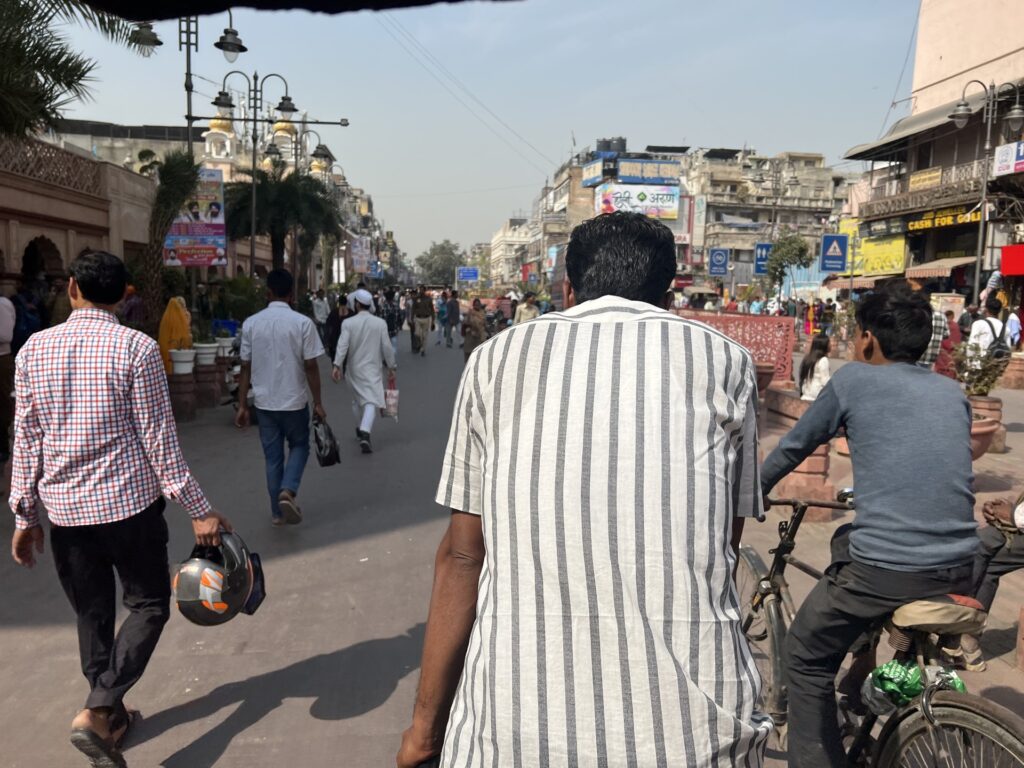
There are exceptions to that though. For example, there’s a famous street called Paranthe Wali Gali that is known for its fresh-made paranthas. This is very popular with tourists, though we’ve read it’s overpriced and as good as you’ll find elsewhere. We didn’t stop because we were very cautious about food in India.
There’s also a small side street with beautifully decorated Jain houses. In recent years it’s become a popular Instagram spot if you can find it. However, you might get charged for photos or invited to shop inside an owner’s wildly overpriced pashmina shop.
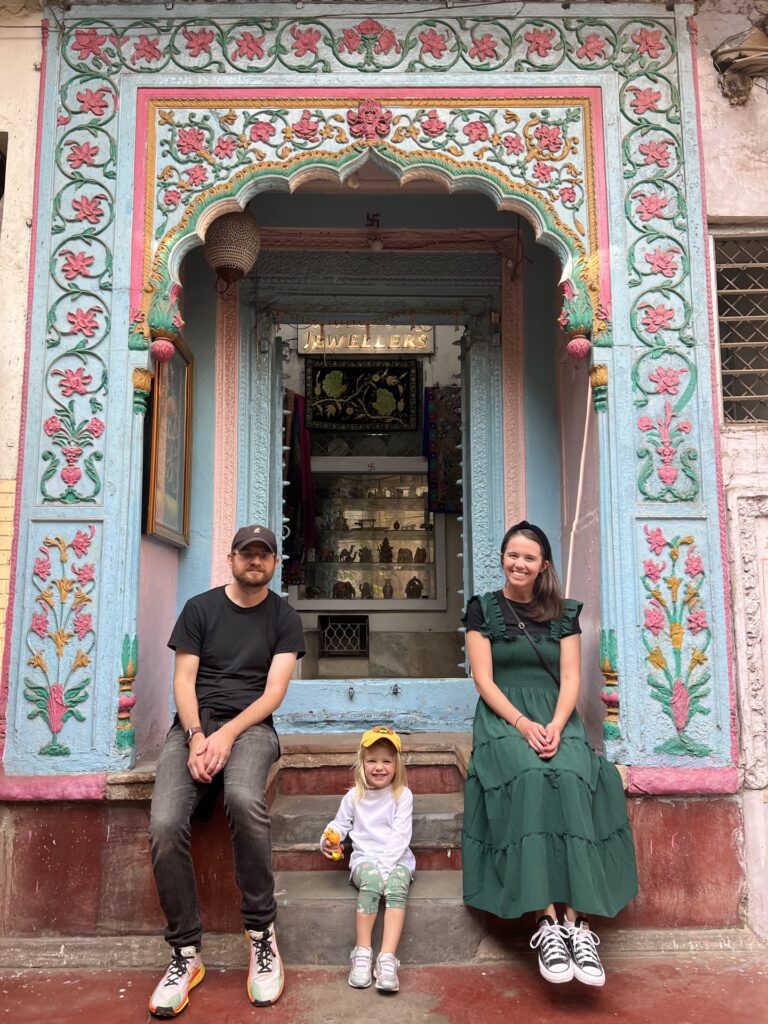
If you want to explore Chandni Chowk — particularly if you’re a western tourist like us — get a rickshaw to take you through it. This market is pretty intense (crowds, traffic, soliciting), so it’s not really great for a stroll. A rickshaw will make the experience much more pleasant, and won’t be that expensive. You can also ask to walk through part of it, and you’re driver will find a good area for you to do so.
You can hire a Rickshaw from the start of Chandni Chowk Road. Most drivers will have a recommended route and will drive you through in about 20 minutes for about Rs. 50-100 (about $1 USD). I’d recommend tipping on top of that, especially if they provide some information about the market for you.
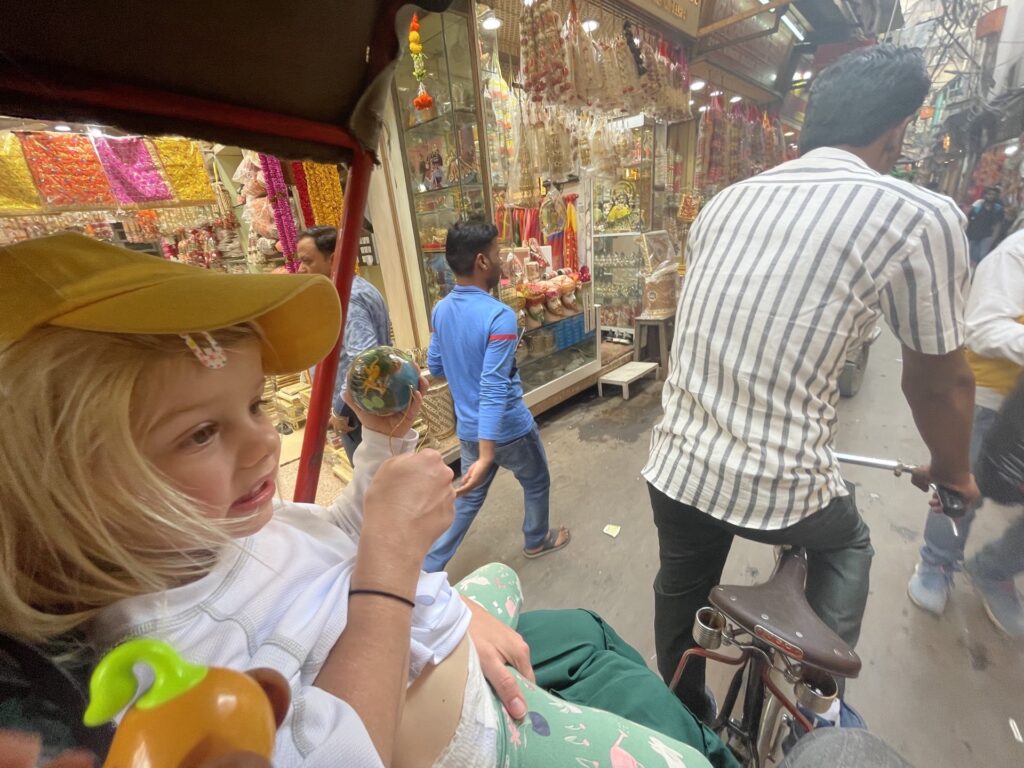
More to do on day 1
We personally wrapped up after Chandni Chowk. We had our rickshaw driver take us back to the mosque, where we met our car driver to take us back to our hotel. These three sites kept us busy all morning, from our 8 AM pick-up to 12:30 PM drop-off.
The morning was very exciting, so we didn’t have a problem spending the later half of our day at our hotel. We ate lunch, napped, and then spent a few hours at the pool. This was a perfect balance for us, and something we’d recommend if you are traveling with kids.
However, there’s definitely more things you can add to fill out your afternoon. Here are two of the things I had on my list for this day, that we didn’t end up doing.
- Raj Ghat & National Gandhi Museum: Raj Ghat is a memorial to Mahatma Gandhi, the peace activist and father of India. You can see a small monument here and then cross the street learn more at the National Gandhi Museum and Library.
- Gurudwara Sis Ganj Sahib: This Sikh temple is located in the heart of Chandni Chowk. It’s free to enter, and they even offer free meals to anyone who needs them. Head to the visitor’s desk near the entrance and someone will show you around, for which they accept tips.
Day 2 — Old meets new
On our second day in Delhi, we leave behind the busy and crowded streets of Old Delhi and explore more of what New Delhi has to offer. We’ll start with one of the oldest sites in the city and then jump to one of the newest.
The sites on today’s itinerary are much more spread out than in Old Delhi. You’ll definitely want to transit in a car (as opposed to a tuk tuk), because it’s faster. Since there’s a lot of driving and multiple stops, we’d recommend booking a car and a driver for the day. We completed this itinerary in 5 hours, but 6-8 would be much more comfortable. Alternatively you could get an Uber for each leg.
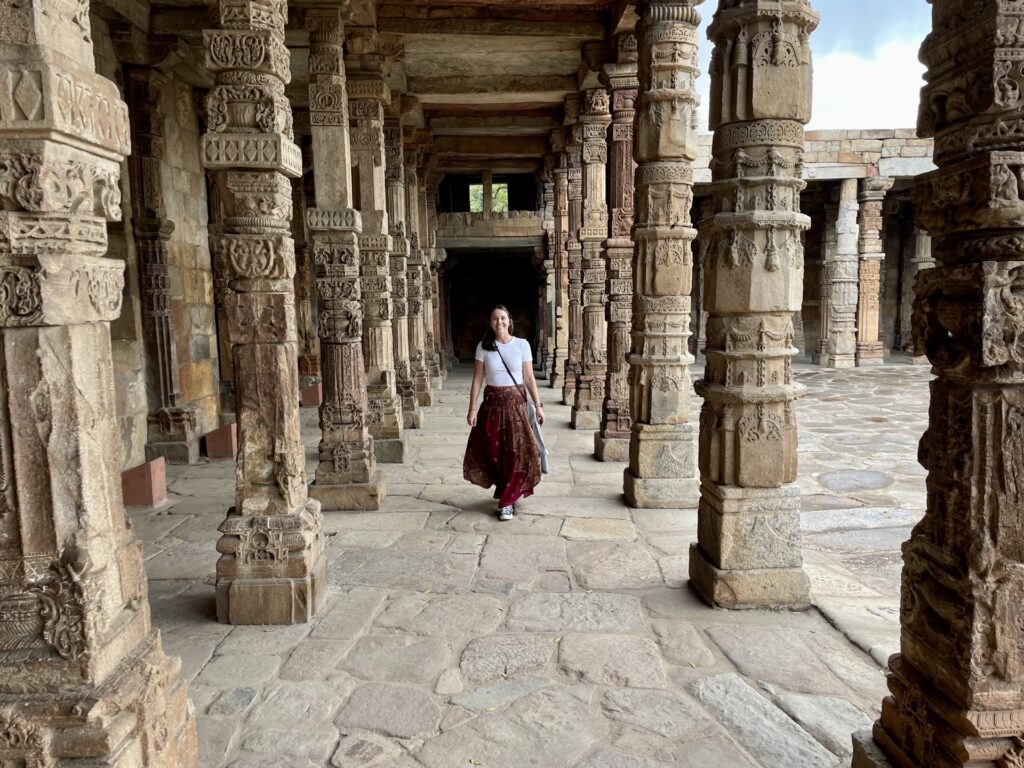
Qutub Minar (also spelled Qutb Minar)
- Location: Here – on the south side of the city
- How to get there: It’s pretty far south, so you’ll need to take a car service or Uber
- Hours: 7 AM – 9 PM everyday
- Price: Rs. 550 ($7 USD)
- Tickets: You can purchase tickets online in advance here. There’s also a ticket booth across the street from the entrance.
- Guide info: We did not notice any guides for hire outside the site. Signs inside were posted in both English and Hindi.
- How long does it take: 1 hour
- Tips: Arrive before 10 AM for low crowds and cooler temperatures. Also consider grabbing a coffee first at Blue Tokai Coffee not far from the entrance.
Qutub Minar is a UNESCO World Heritage site where you can see the ruins of Delhi’s oldest fortified city, dating back to the 1200s. The complex includes a handful of tombs and a mosque, in addition to the namesake minaret. The minaret itself is the tallest stone minaret in the world and the second tallest minaret in India after the Taj Mahal. There’s a beautiful and photogenic courtyard of Mughal archways and lots of lush, green grass.
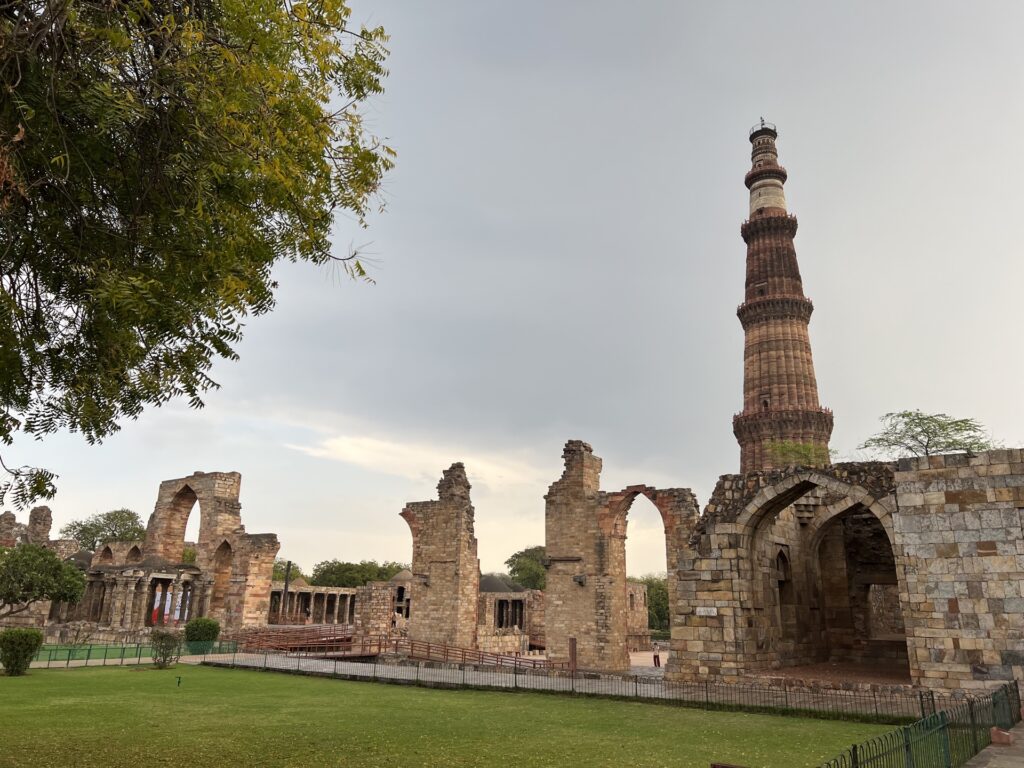
The entrance to Qutub Minar is on the east side of the complex across the street from the ticket office. You can skip the ticket office and go straight to the gate if you buy your tickets online. Follow the main entrance in and you’ll see the minaret to your left. We suggest starting to the right to see some of the other ruins first, and then finishing at the minaret.
Even though Qutub Minar is one of the most popular tourist attractions in Delhi, it didn’t originally sound that interesting. And if you look at it objectively, maybe it isn’t.
It turned out to be the highlight of our trip though. This was surely a matter of circumstance — we had a perfectly cool morning, zero crowds, and a really happy toddler who loved running up and down the ramps. I wouldn’t say you must go to Qutub Minar, but I will say that we enjoyed it so much more than we expected and we hope you do too.
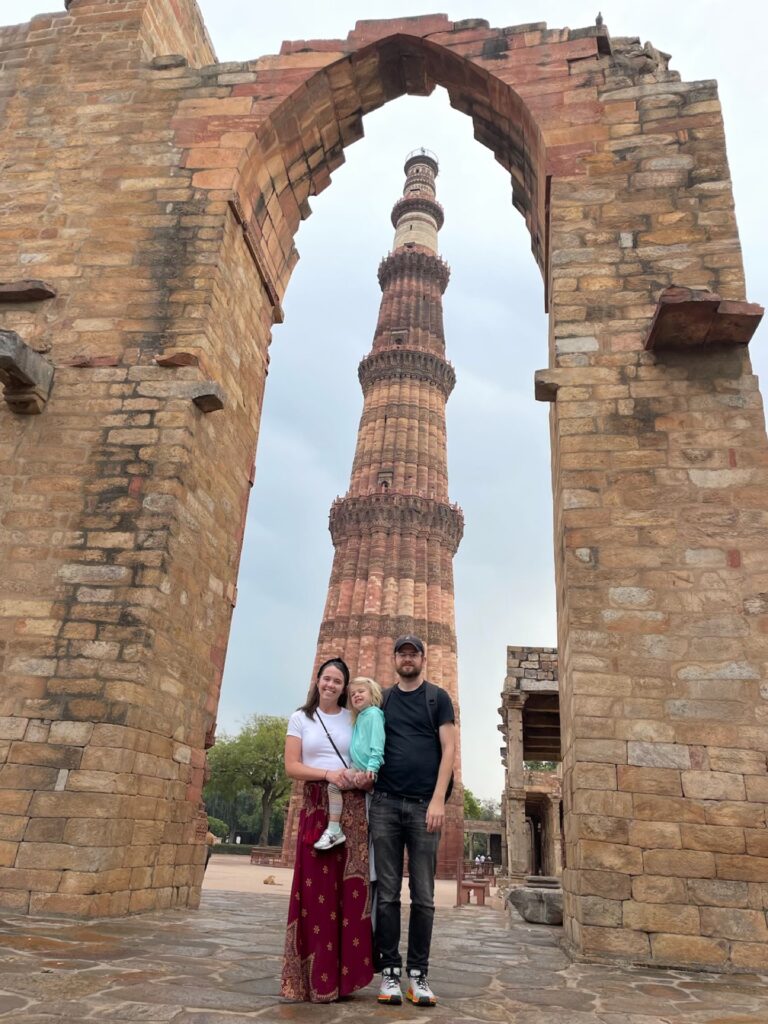
Akshardham Temple
- Location: Here – Across the river east of Humayun’s Tomb
- How to get there: It’s a hike from Qutub Minar, so you’ll need to take a car service or Uber
- Hours: Tuesday through Sunday, 10 AM – 6:30 PM. Exhibitions don’t start until 12:30 PM and the water show is at sunset. Closed on Mondays.
- Price: Entry is free. Tickets for special exhibitions cost Rs. 250 (3$ USD) and the water show costs Rs. 90 ($1 USD)
- Tickets: Tickets for exhibitions are sold from the ticket window inside the temple complex.
- Guide info: Printed guides are available in the visitor center in a variety of languages, but they were sold out of English during our visit so don’t bank on them.
- How long does it take: 2 – 4 hours, depending on lines and if you do the exhibitions.
- Tips: Unless you want to do the exhibitions, go early to beat the heat. Also be sure to review the things to know section below.
Akshardham Temple was described to me as the Disneyland of temples, and once I heard that I couldn’t not see that. While Disneyland is actually very much more exciting, the long security lines, manicured gardens, and a beautiful faux-historical building at the center are definitely similarities between the two.
The main attraction is the temple itself, which is impressive in both size and detail. It was built pretty recently (in 2005), so there is no historical significance to it. The inside of the temple is beautiful and you can follow a small loop past different shrines. You must take off your shoes to enter the temple and there’s a shoe check available.
In addition to the temple, there is a nice garden with statues to walk through, visitor center, a food court, large children’s playground, and a souvenir shop. It takes about an hour to just walk through the temple and the rest of the grounds.
Then comes the “Disneyland” component. There are three exhibitions — an animatronics exhibit, a film and a boat ride —where you can learn more about Hindu heritage and culture. Combo tickets are sold for all three exhibitions, and you cannot buy a cheaper ticket for just one.
What Disneyland day would be complete without a nighttime show? Akshardham has a nighttime light and fountain show that actually looks really cool. It was too late for us to go with a toddler, but it seems to be really popular.
The temple was pretty and we enjoyed our stay, but it is a lot of hoopla for something you can’t take photos of, so it might not be for everyone.
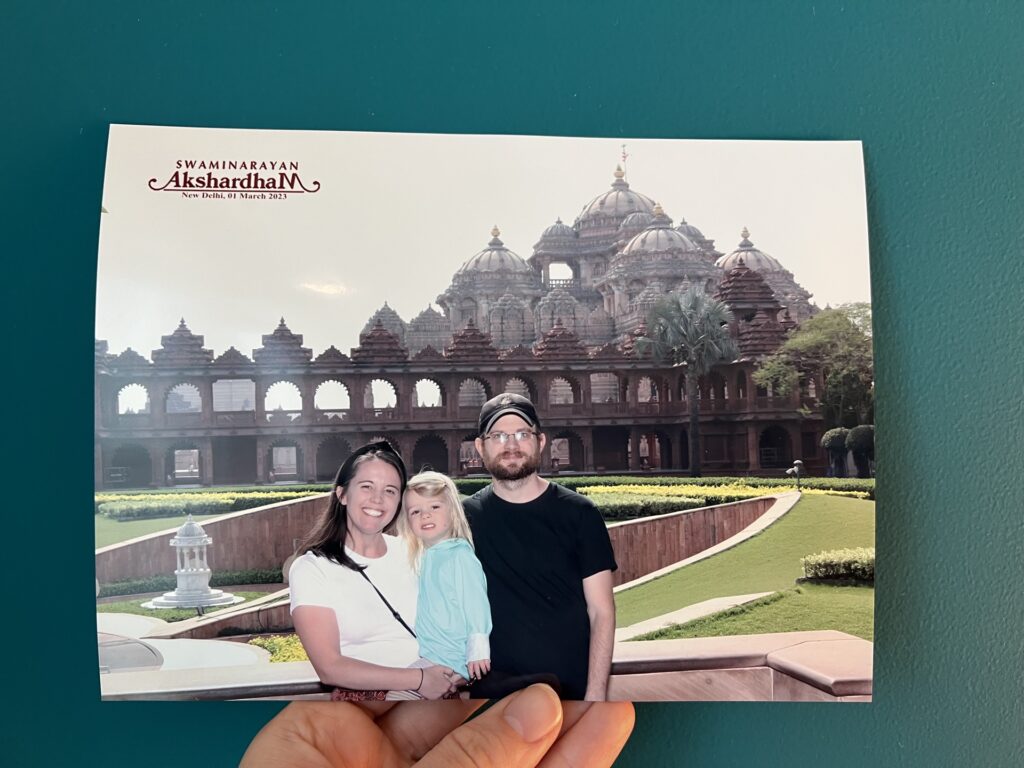
Things to know about Akshardham Temple
- There’s a dress code. Your shoulders, chest, navel, upper arms and knees must be covered (men and women) at all times.
- Photography is not allowed. If you want a picture with the temple, there are two locations inside where you can can purchase photos. The side-view location near the foodcourt costs Rs. 70 and the front-view location near the exhibition ticket booth costs Rs. 140 and up. You can pickup your print 20 minutes later near the exit.
- Cell phones and cameras are not allowed. Even if you aren’t planning to sneak a photo, cell phones are not allowed inside. (And they will check!)
- Security is very thorough. Expect airport-style security at the entrance. There are metal detectors and scanners for everyone and everything, so don’t try to sneak in any contraband. There are separate queues for men and women. Since you can’t have a phone, you will need a plan for meeting up after security. There are benches on the other side of security, so that’s a good place to meet.
- Lines can get really long. The line to get through security and enter the different exhibitions can get really long. During the day, there were large groups of school children and I assume there’s another rush for the fountain show. Be sure to give yourself some buffer time in your schedule to account for the wait.
- Large bags are not allowed. Backpacks and other large bags are not allowed, but women can bring a small purse.
India Gate
- Location: Here – in the center of a park surrounded by a busy traffic circle
- How to get there: Take a car service or Uber from Akshardham Temple to India Gate. Cars can only pull over on the west side of the gate near this viewing point.
- Hours: You can view the gate anytime.
- Price: Free
- Tickets: N/A
- Guide info: N/A
- How long does it take: 30 minutes
- Tips: You can only enter the park around India Gate from certain entry points, including the west side viewing point. There’s a light security check and armed guards at the gate.
India Gate is a large war memorial that is similar in style to several other famous moments around the world, including Arc de Triomphe in Paris. It was built to remember the British Indian Army soldiers who died in WWI.
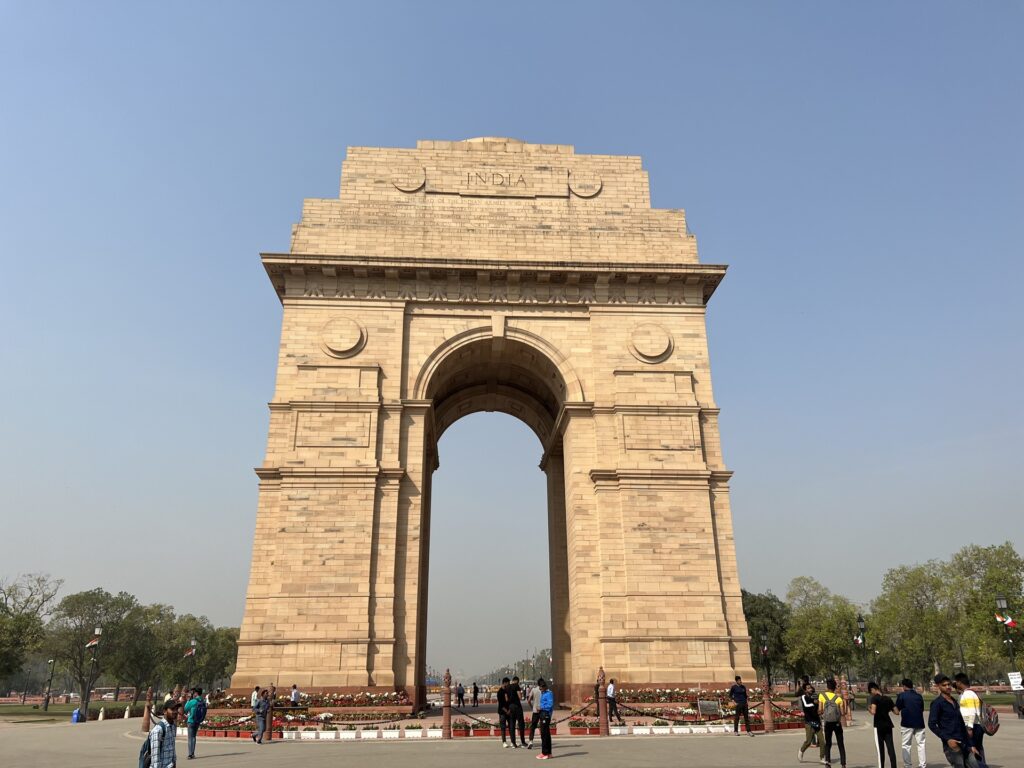
The memorial is situated inside a busy traffic circle. Also inside the circle is lots of park space, a large children’s playground, and the National War Memorial.
India Gate is mostly just a photo op. Take a few minutes for photos, maybe have a snack on the bench in the shade, and carry on.
Agrasen ki Baoli
- Location: Here – About a mile north of India Gate
- How to get there: You could walk this if you wanted, but it’s a boring walk. Fflag down a tuk tuk or take a car/Uber.
- Hours: You can view the step-well anytime.
- Price: Free
- Tickets: N/A
- Guide info: N/A
- How long does it take: 15 minutes
- Tips: There’s some snack carts outside if you want to grab some chips and a drink while you sit.
Agrasen ki Baoli is a step-well, which is a type of well that can be found all around India. Step-wells are a natural water source with steps built up the side so you could reach the water at any depth. Today, most step-wells are no longer in use and serve as meeting places for people to come, sit and socialize. (Or they’re just decorative.)
This specific step-well is pretty small and the steps aren’t as intricate (read: pretty) as other step-wells. If you haven’t seen a step-well before and you don’t have any others planned, it’s worth a stop. Otherwise, I wouldn’t work too hard to get here.
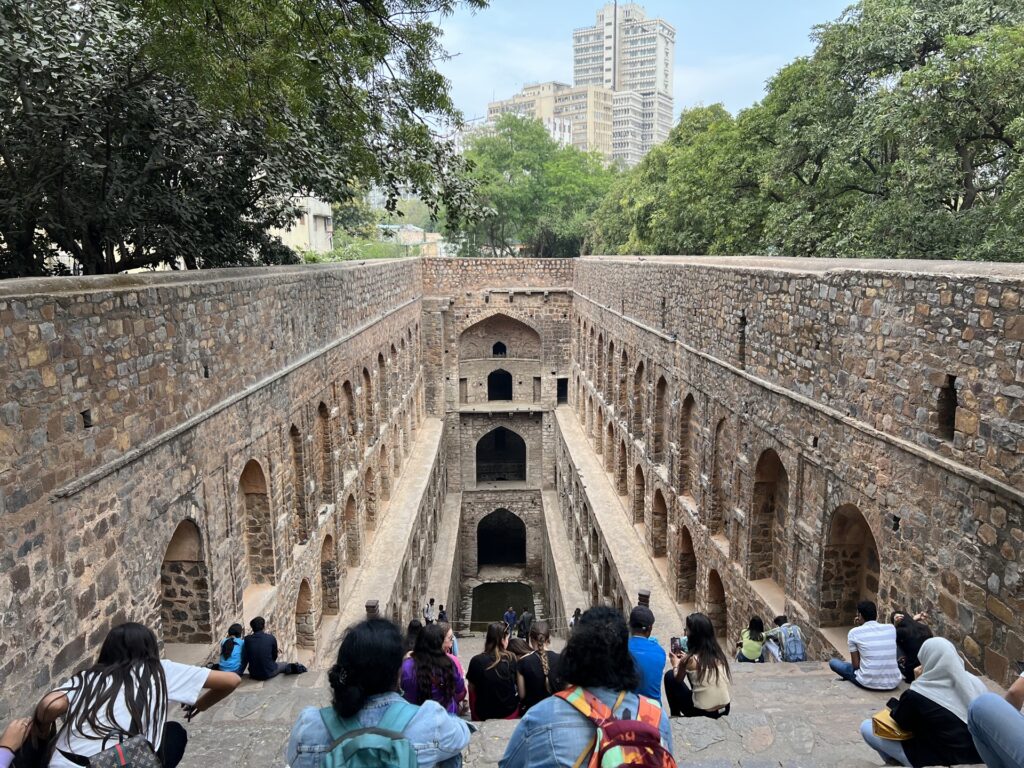
Did I drag my family 30 minutes out of the way to see this step-well? Yes. Did I mistake this step-well for the one in Jaipur that is much cooler? Also yes.
More to do on day 2
This wraps up our second day in Delhi. We were able to hit these four attractions in about five hours, but that was tight. We easily could have spent another hour our two if we had more time. (Again, we were kind of on the clock to get our kid back for nap time.)
If you finished quickly or wanted to pack more into your day, here are a few other things that would pair nicely with this schedule. The first two you’ll want to do between Qutub Minar and Akshardam Temple, and the second two would fit nicely after India Gate and the step-well.
- Dilli Haat: If you’re interested in shopping, this large bazaar is a great place to buy handicrafts, souvenirs, and foods from all over India. It’s much more relaxed than other markets in Delhi (especially Chandni Chawk), and prices tend to be higher and fixed. There is a small fee (Rs. 20) to enter.
- Lotus Temple: There are only 7 Baha’i Temples in the world, and Delhi has one of them. It’s a beautiful lotus-shaped temple that somewhat resembles the Sydney Opera House. The temple is open to visitors everyday but Monday.
- National Museum, New Delhi: This museum is located along the mall not far from India Gate. There are several museums around here, but this one is great for India history and art.
- Connaught Place: This touristy district is close to the step-well. In the center of the circle is a large park, and around it are many big name stores, hotels and restaurants.
Day 3 — Mughal tombs and garden oasis
On our last full day in Delhi, we’ll observe more of the Mughal architecture that is so famous throughout India. This style — which fuses Hindi, Persian and Islamic elements — is recognizable by the bulbous domes, white marble and sandstone structures, and scalloped archways. Or to say it simply, it’s the same style as the Taj Mahal.
After a busy three days, we’ll finally take a break to relax and unwind in Lodhi Garden.
Humayun’s Tomb Complex
- Location: Here – Directly south of the Delhi Zoo
- How to get there: Have a car/taxi/tuk tuk drop you off
- Hours: 6 AM to 6 PM, everyday
- Price: Rs. 550 ($7 USD)
- Tickets: You can purchase tickets online in advance here. There is also a ticket booth at the entrance.
- Guide info: We did not notice any guides for hire outside the site. There were a couple signs throughout the complex in both English & Hindi, but not many.
- How long does it take: 1.5 hours
- Tips: As with all things in Delhi, arrive early to beat the crowds and heat. If there’s no one at Isa Khan’s Tomb when you arrive, go there first for great photos.
Many of the most beautiful and important structures in India are tombs from the Mughal Empire (1526–1761). Humayun’s Tomb was one of the first of this time period, and notably it was the first garden tomb. This style of tomb, which prominently features lush and manicured gardens and waterways, influenced many other tombs of the era, including the Taj Mahal.

Just west of Humayun’s Tomb is Isa Khan’s Tomb. This tomb is much smaller (though I would argue it’s more beautiful) and does not have the large surrounding gardens. It was built before Humayun’s and in the Lodhi style, which is evident by it’s octagon shape (different from the square shape of Humayun’s).
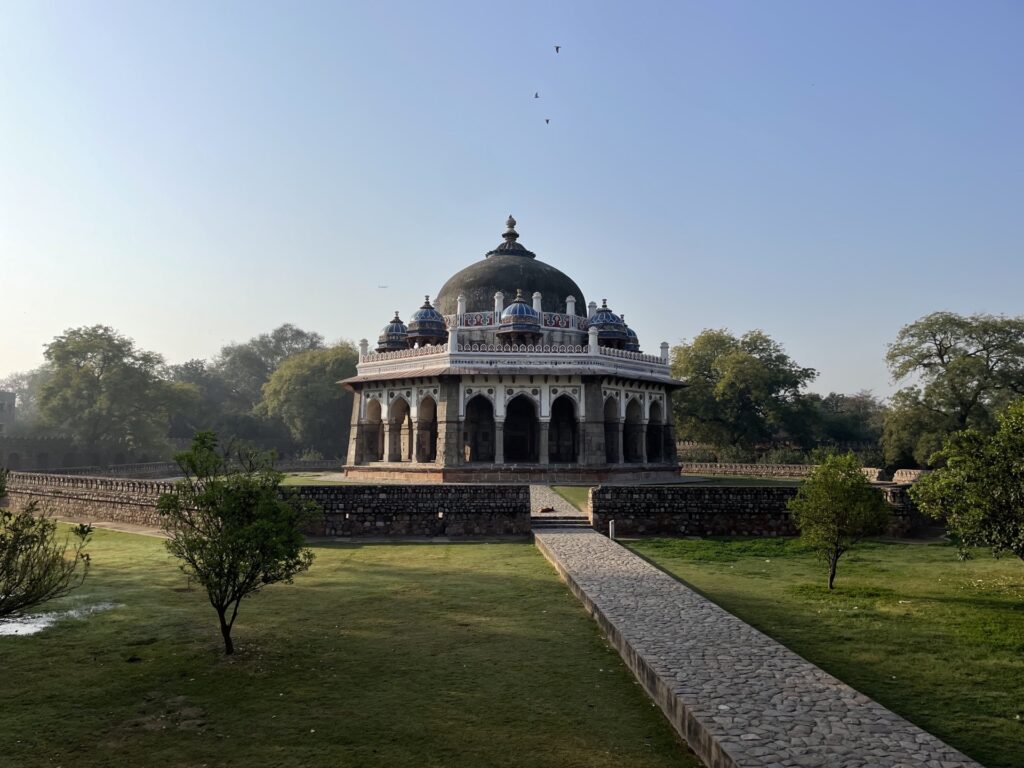
In the middle of these two tombs is Afsarwala’s Mosque and Tomb. Unfortunately this area was closed during our visit.
There is one ticket for all three tombs. The ticket window and entrance is located here on the west side of the complex. The main vehicle drop off point and entry gate is usually north of the ticket window here. During our visit, that entrance was closed and we had to enter from the west side near Sabz Burj Circle.
Once you’ve entered the complex, you can explore the tombs and gardens. You can climb to the top and go inside Humanyun’s tomb, which includes many different rooms. You can also go inside Isa Khan’s Tomb, though it’s quite small. To be honest, these tombs are most impressive from the outside so enjoy the different vantage points as you stroll through the gardens and around the complex.
Safdarjung Tomb
- Location: Here – West of Humayun’s Tomb near Lodhi Garden
- How to get there: Take a car/taxi/tuk tuk from Humayun’s Tomb
- Hours: 7 AM to 5 PM, everyday
- Price: Rs. 550 ($7 USD)
- Tickets: You can purchase tickets online in advance here (select Delhi > Safdarjung Tomb). There is also a ticket booth at the entrance.
- Guide info: We did not notice any guides for hire outside the site. There were a couple signs throughout the complex in both English & Hindi, but not many.
- How long does it take: 30 minutes
While Humayun’s Tomb was the first garden tomb of the Mughal Empire, Safdarjung’s Tomb was the last. Built in the waning years of the empire, the tomb is often criticized for lacking the proportions and quality of the grander tombs that came before it. It is also the only tomb built for someone outside of the imperial family.
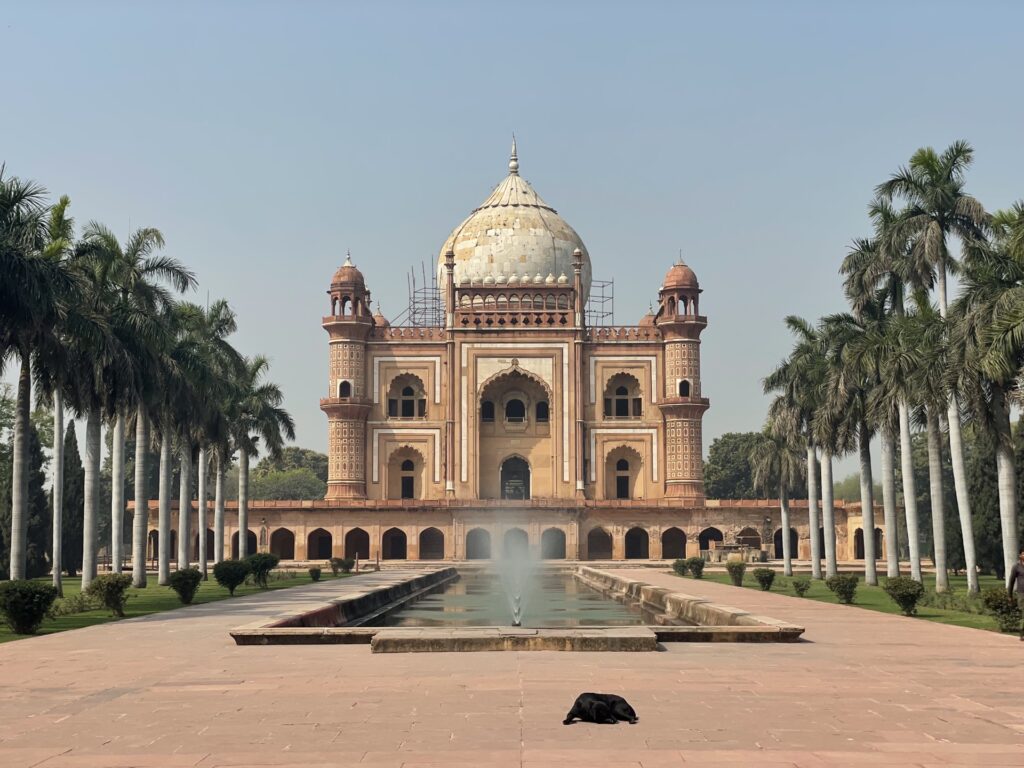
The gardens in front of the tomb are well manicured and there is a working fountain prominently leading up to the tomb’s entrance. There was some construction going on during our visit and the back half of the gardens were looking quite drab. You can go to the upper level of Safdarjung’s Tomb, but the inside was closed for renovations.
This tomb isn’t the most popular, but we actually liked that about it. We liked the working fountains and palm trees at the entrance and appreciated it’s smaller size. It was nice, but not a must-do.
Lodhi Garden
- Location: Here – Just east of Safdarjung Tomb
- How to get there: You could easily walk to Lodhi Garden from Safdarjung Tomb. If you are arriving by car, ask them to drop you off at the south entrance here.
- Hours: 6 AM to 8 PM, everyday
- Price: Free
- Tickets: N/A
- Guide info: There are several signs discussing the plants and wildlife as well as maps posted throughout the park in English and Hindi.
- How long does it take: 1 – 2 hours
- Tips: If you’re hungry, pick up some packaged snacks or drinks from the sellers at the entrance. They aren’t allowed to sell inside the park.
Lodhi Garden is a large, beautiful park in the heart of Delhi where you’ll find much needed green space and peace and quiet. There are a few tombs dotted throughout the park, but most people come here to take a break from sightseeing.
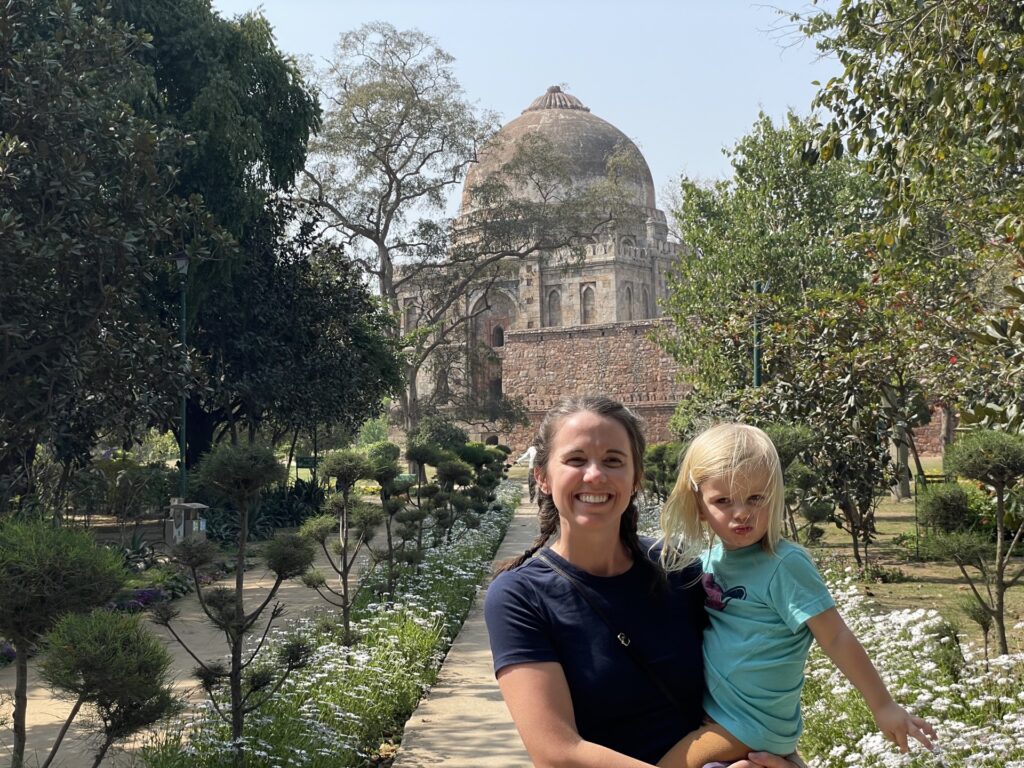
We suggest starting your visit at the south end of the park and then looping up and around. Stroll along the flower-lined pathways and try to spot some of the many birds that call this place home. Then take a walk through the rose garden if it’s blooming and circle around the pond to see the geese before taking a different path on your way back.
It’s a large park, but a casual stroll through it will probably only take about an hour. If you want a longer break though, you could easily spend more time here.
Overall, we loved our time at this park. However, I have to warn you that we were harassed by a very aggressive bug. I honestly don’t know if it was a stinging bug, but it was very large and very loud and would not leave us alone. We literally ran through the park screaming and swatting, kid crying, trying to escape it. This really ruined the park for us and we left immediately.
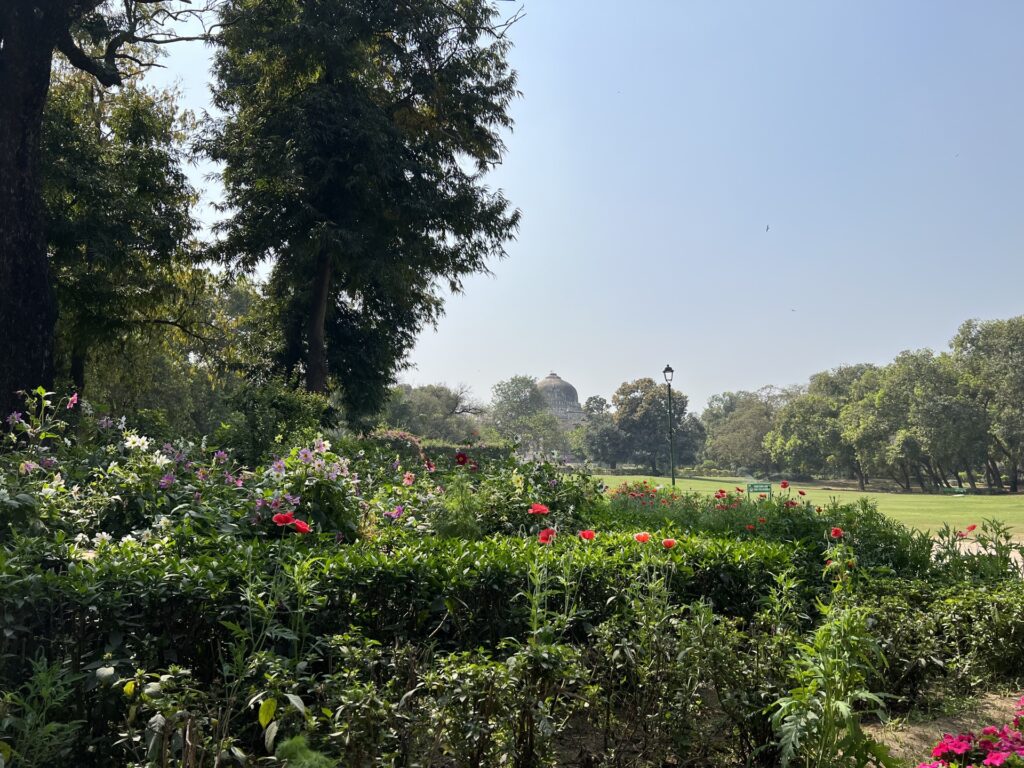
More to do on day 3
After the park, we retreated to our hotel. Just like the past two days, we completed this itinerary between 8 AM and 1 PM. We had more than enough time at each site, but we could see people wanting to spend more time at the park.
If you have more time and energy, here are a few more things that would stack nicely with this itinerary.
- National Railway Museum: This museum explores the history of trains in India. There are a few different trains you can actually ride, plus lots of models, replicas and full-size old trains to see.
- Lodhi Colony: This is India’s first official art district. There is street art and murals throughout the neighborhood and it’s described as an open-air art gallery. You can find a map with several of the prominent pieces here or get a more detailed art analysis of many of the works here.
- PVR Directors Cut: If you want to see a Bollywood film while you’re in India, this the place to do it. PVR is a movie theater chain in India, and Directors Cut is their luxury cinema brand that features reclining seats, in-seat dining service and better A/V quality. There’s a Directors Cut location in Ambience Mall on the far southwest side of the city. (It’s actually pretty close the airport. If you’re spending a night at an airport hotel before you fly out, this would be a fun way to spend the evening.)
10 tips for visiting Delhi
- Don’t drink the water. Traveler’s diarrhea is extremely common among travelers to Delhi (and all of India), and it’s usually caused by contaminated water. Definitely don’t drink tap water in Delhi. Instead, rely on bottled water or invest in a water purifier bottle. (We have this one.)
- Don’t consume anything that has touched tap water. This goes right along with don’t drink the water, but it’s sneakier. Avoid uncooked produced or only eat fresh produce that has a thick peal (bananas, oranges), watch out for ice, brush your teeth with filtered water, etc.
- Research restaurants in advance. This is my last food safety PSA, I swear! Because the water isn’t safe, you should be really careful about what and where you eat. This means you shouldn’t always go to the first restaurant you see. Research restaurants in advance and save them to Google Maps so you know where to go when you’re hungry. Restaurants with lots of positive reviews are probably okay.
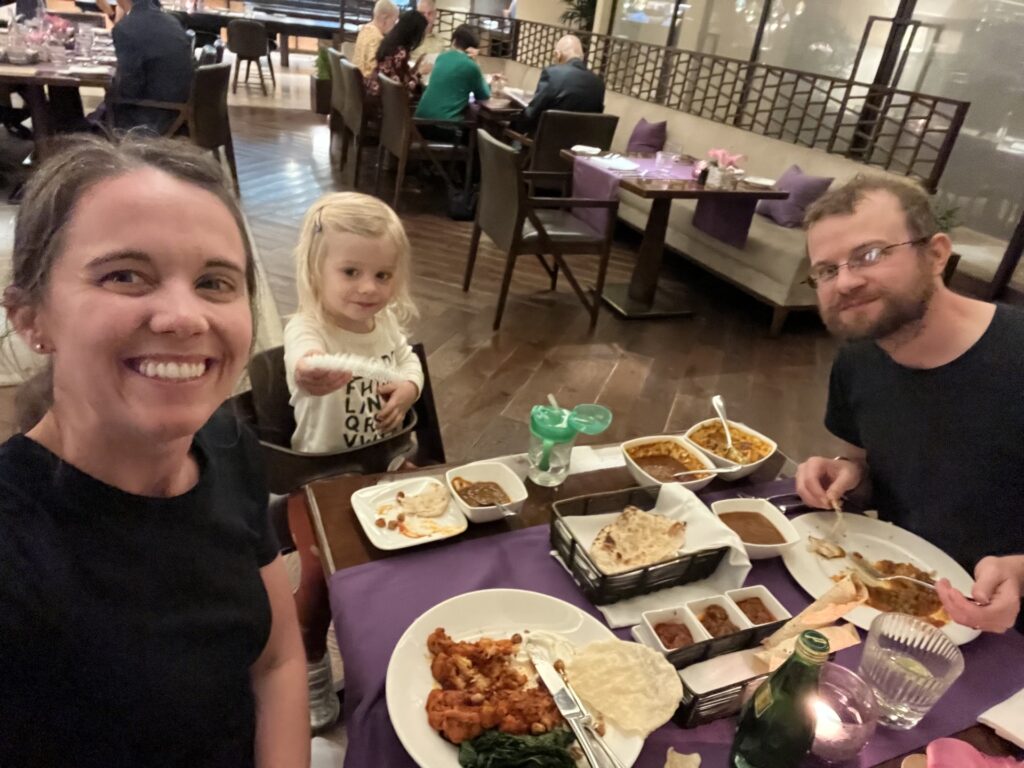
- Buy tickets in advance when you can. You can buy tickets online in advance for most major sites in India. This will save you time waiting in the queue. It’s best to buy your tickets one day in advance.
- Go early. Indian tourists tend to be slow to rise. They’ll hit the tourist sites in droves midday and into the afternoon. If you go in the first hour or two a site is open, you can usually beat those crowds. It’s also cooler in the morning.
- Book a car. If it is in your budget, we’d recommend booking a car with a driver to take you around the sites. You can usually coordinate this with your hotel. It’s not something we’d usually recommend, but it’s just the easiest way to get around since the Metro isn’t always a convenient option and sites are spread out.
- Carry cash. Keep at least a thousand Rupees ($12 USD) in smaller bills on you at all times. You’ll need cash to pay for things like tuk tuks and rickshaws, snacks and drinks from small stands, and even entry to certain sites if you don’t have tickets yet.
- Bring a baby carrier. Delhi isn’t great for strollers, for the same reason it’s not great for walking. If you have young children, keep them in a baby carrier. (We review our favorite baby carriers for travel in this post.)
- Stay at a nice hotel if you can. Delhi is incredible, but it can also be a lot to take in. If you can afford to stay at a nice hotel, it is a really good way to relax and recharge between excursions.
- Tip everyone. Everyone who does something for you — like takes a photo, gives you directions, shares information about a site — is usually going to ask for a tip. I’m a seasoned traveler and still fell for the old “let me take your photo” trick. In most cases, Rs. 100 ($1 USD) is enough, but it depends on the situation.
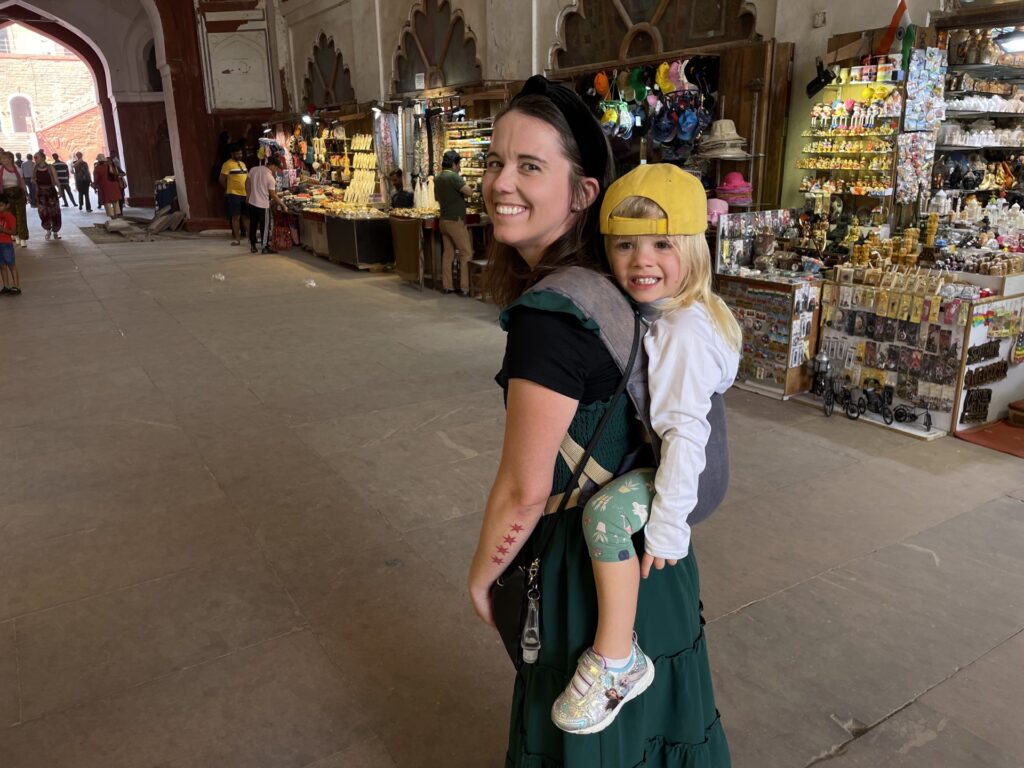
Closing thoughts on Delhi
We had an amazing time in Delhi. The city was unlike anywhere I’ve ever been before, and it far exceeded my expectations going into it.
To be completely honest, I wasn’t overly excited about India at first. Reading about it was exhausting and I felt like everyone framed the city as being chaotic, noisy and overwhelming. Maybe it’s because I came in prepared for the worst or because I’ve got a lot of travel experience under my belt, but I just didn’t feel that way.
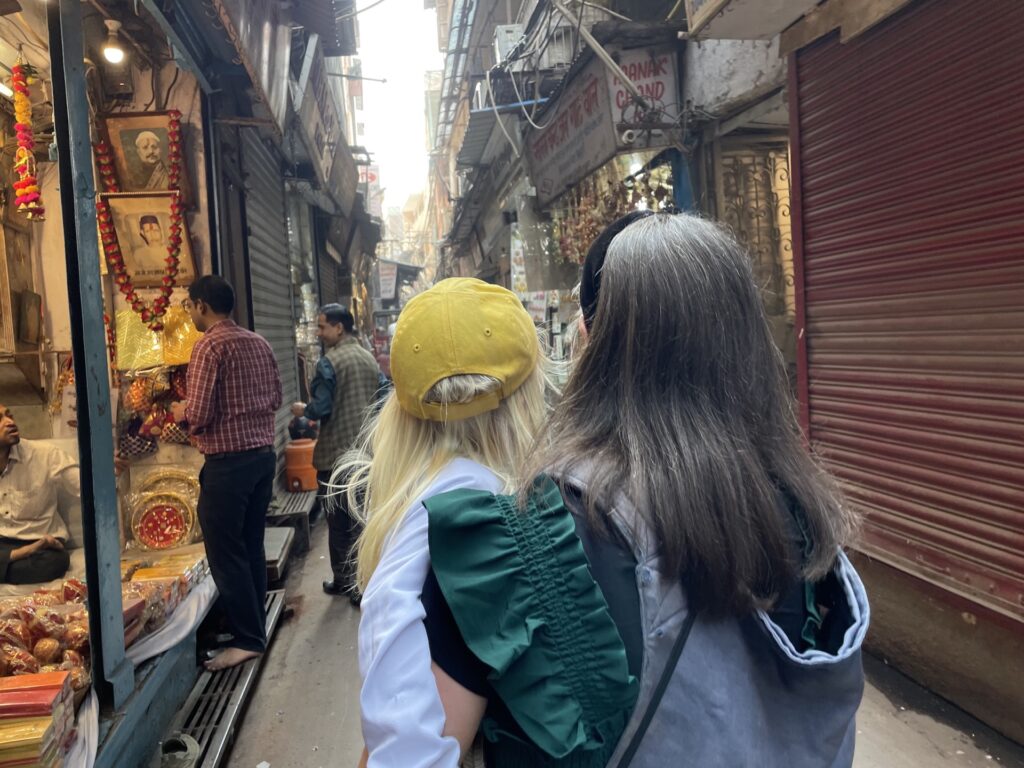
In my introduction to Delhi, I described the traffic as soothing, and I think that’s actually how I felt about the whole city. There was so much going on, but it was all so fluid. Everyone (except me) knew exactly what was going on, and I was just standing quietly watching it unfold. It was a good reminder that people, places and things can exist in ways that don’t perfectly align and cater to own personal preferences and that’s okay.
I don’t know when I’ll be back in Delhi, but I do know that I won’t rule it out. India is huge and there’s so much of it that we haven’t seen. If we end up on a flight connecting in Delhi, I’ll welcome the chance to see more of this city.
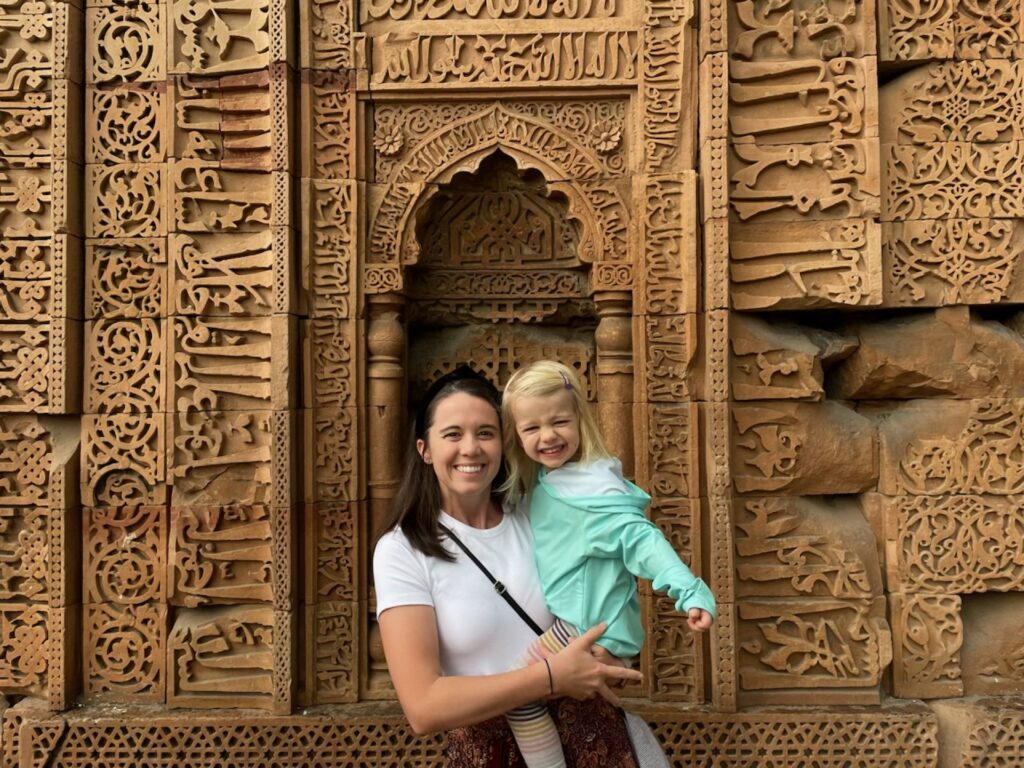
More From This Trip
- Emirates Business Class Review – A380 JFK to DXB
- Our Stay at Atlantis Dubai – A Perfect Place to Recharge
- Detailed 2-Day Dubai Itinerary
- Air India Business Class Review – 787 from DXB to DEL
- A Parent’s Guide to Traveling to India with Kids
- India Golden Triangle in 10 Days [Travel Guide, Itinerary &Tips]
- 3 Days in Delhi – Sample Itinerary + Planning Guide
- The Oberoi New Delhi Hotel Review
- Jaipur Itinerary – 1 or 2 Days in the Pink City
- Review of Jai Mahal Palace (Jaipur)
- Train from Jaipur to Udaipur – AC 3-Tier Sleeper Class
- The Oberoi Udaivilas Hotel Review (Udaipur)
- Udaipur Travel Guide + Things To Do
- Celebrating Holi in Udaipur (With a Kid)
- Overnight Train from Udaipur to Agra – AC First Class Sleeper
- The Oberoi Amarvilas Review: A Luxury Hotel with Taj Mahal Views
- Kerala Express Review – Agra to Delhi in AC 2-Tier Sleeper Class
- Hotel Review: JW Marriott New Delhi Aerocity
- Qatar Airways Economy Review – DEL to DOH
- Doha Things To Do & Travel Guide (Perfect for a Stopover!)
- Qatar Airways Qsuite Review – 777 from DOH to JFK
